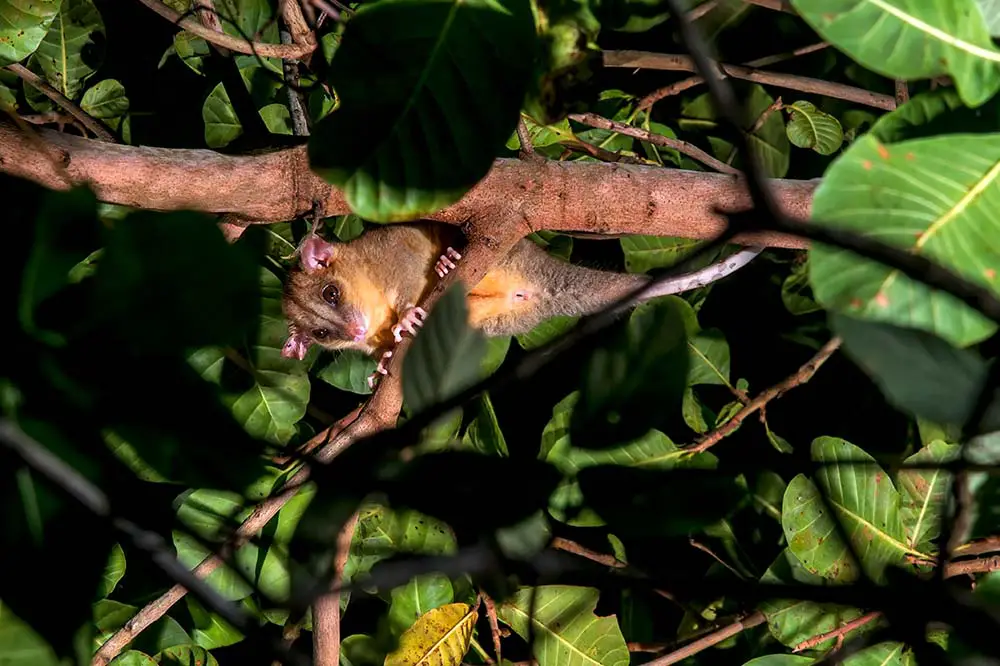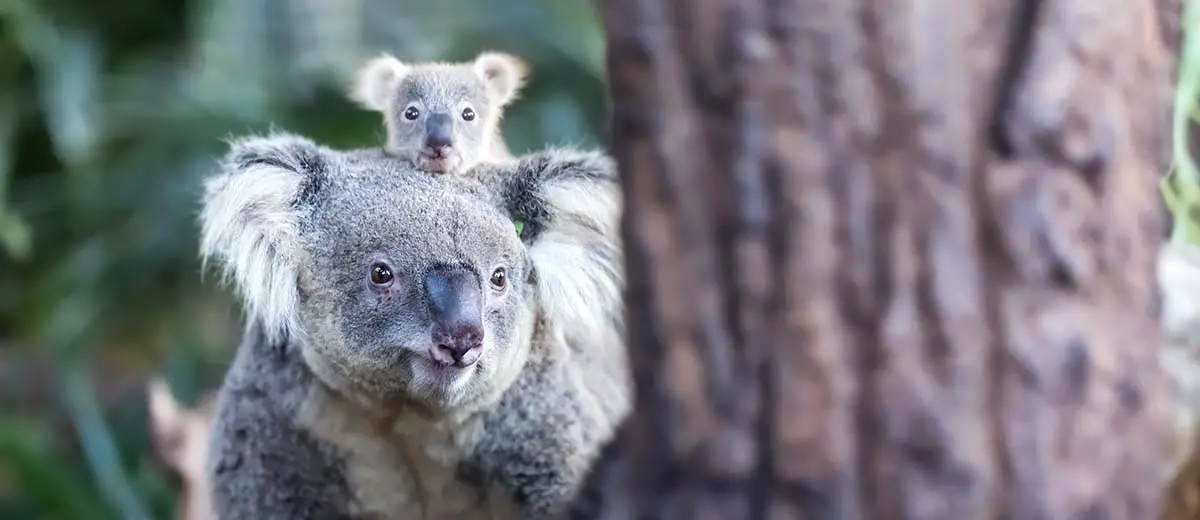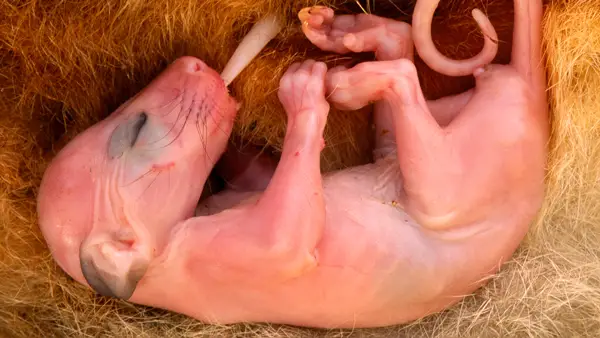50+ Species of Marsupial from All 19 Families
Marsupials are one of three types of mammal, differing from placentals and monotremes by their reproductive strategy; after a short gestation period, females give birth to premature young, which make their way to the marsupium where they are further nourished by milk. In many species, the marsupium takes the form of a fully developed pouch but can be much less substantial in others.
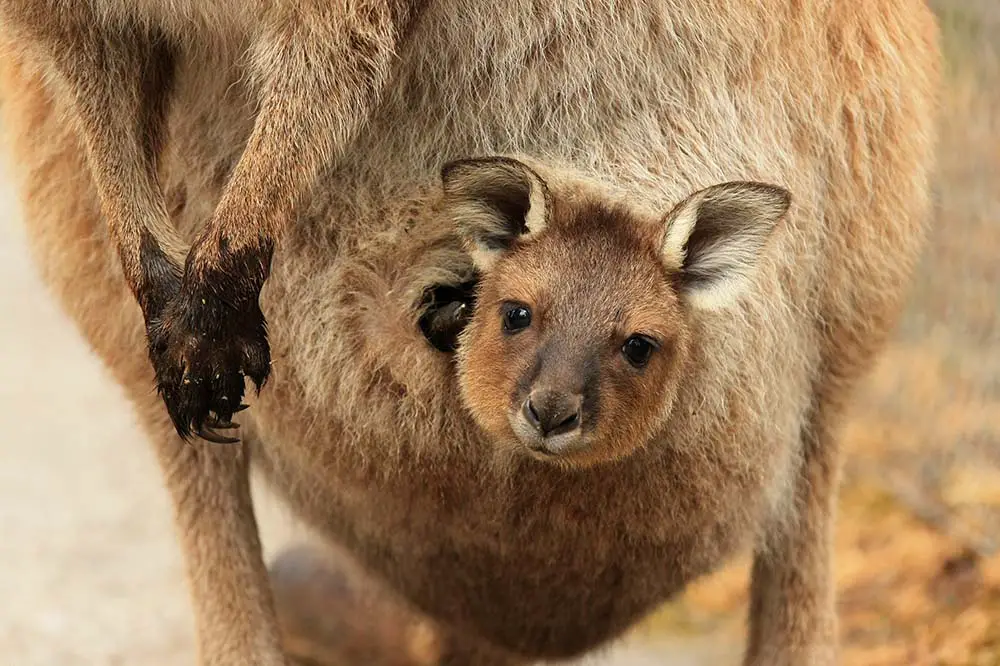
At the most basic level, marsupials are grouped into two superorders that, with the exception of one species, are completely separated geographically. The members of Ameridelphia are located in the Americas and are grouped into 2 orders which contain species of opossum and shrew opossum. The members of Australidelphia, which we’ll cover first, are grouped into 5 orders. 4 of these are located on the other side of the planet in Australasia and contain arguably the most well-known marsupials; kangaroos and wallabies, the Tasmanian devil and quolls, koalas and wombats, the sugar glider, and many other heartwarming species.
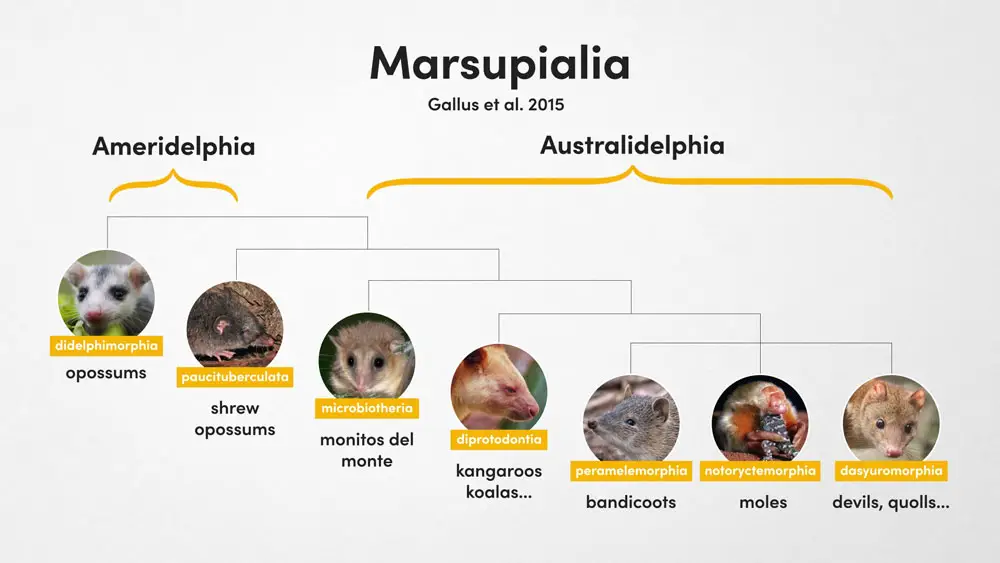
Contents
- Dasyuromorphia (Tasmanian Devil, Quolls, Numbat…)
- Diprotodontia Introduction
- Vombatiformes (Koalas & Wombats)
- Macropodiformes (Kangaroos, Wallabies, Quokka…)
- Phalangeriformes (Gliders, Possums and Cuscuses)
- 4 Smaller Orders (Marsupial Moles, Bandicoots, Monito del monte…)
- Didelphimorphia (Opossums)
Dasyuromorphia
One of the most unique orders is Dasyuromorphia, which contains almost all of the carnivorous marsupials. Interestingly, while larger individuals like the Tasmanian devil feed almost exclusively on meat and are therefore thought of as true carnivores, the smallest members of this order are insectivores—animals who feed on insects or other invertebrates—and are therefore also technically carnivores.
The Tasmanian devil is the largest carnivorous marsupial, weighing up to 12kg (26.5 lbs), it is part of the Dasyuridae family, which contains all but one species from this order. They are generally found on the island of Tasmania but were reintroduced to the mainland in 2011. These animals have powerful jaws and sharp teeth but are known to scavenge, which they do at night. Their gestation period is 21 days, after which pouch life lasts around 4 months.
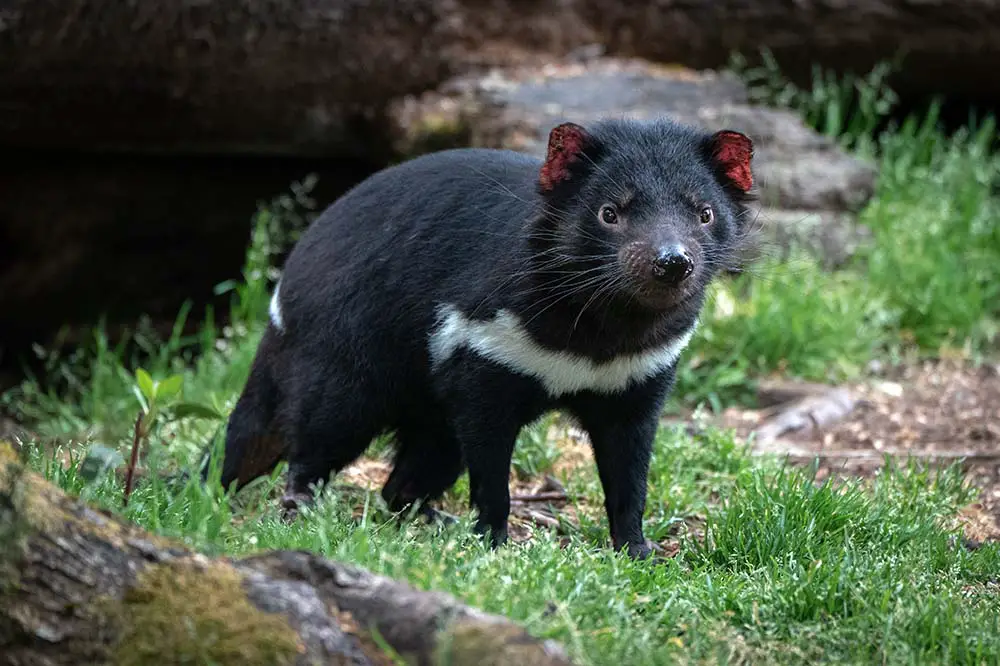
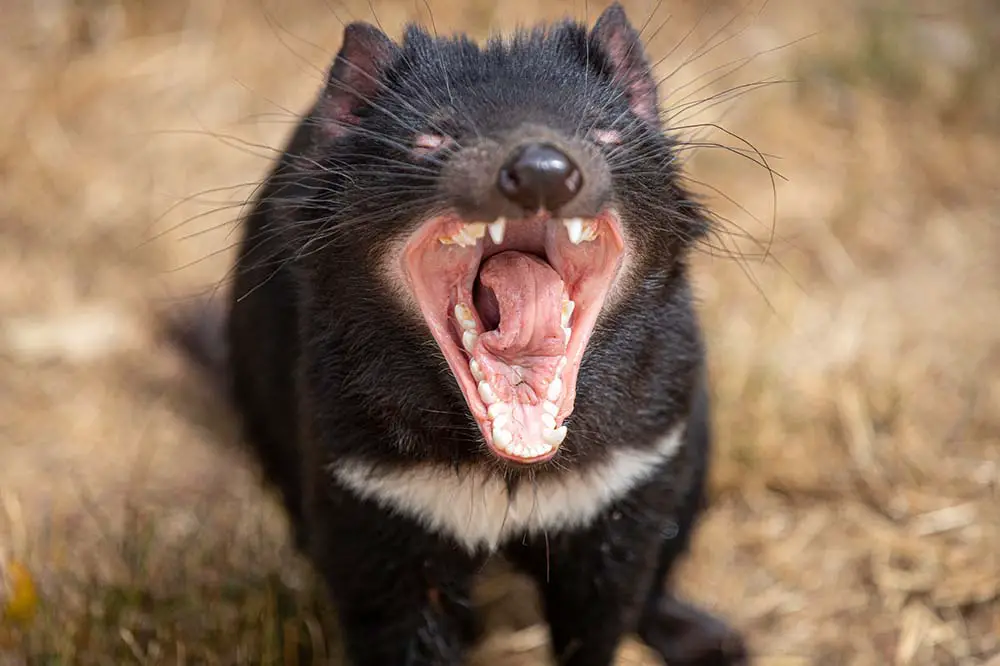
Left: Tasmanian Devil in woodland | james_stone76 / Shutterstock & Right: Tasmanian Devil showing teeth | Merry And The Moon / Shutterstock
Quolls are similar to Tasmanian devils but much smaller. There are 6 species, found in Australia and New Guinea. Weighing just over half of a devil (7kg / 15.5 lbs) the tiger quoll is the largest of the six and is also known as the spotted-tailed quoll. They hunt other marsupials such as greater gliders and red-necked pademelons, along with a variety of other small animals. The eastern quoll is smaller still, weighing no more than 1.5 kg (55 oz). They have a similar pelage to the tiger quoll but can also be found in black, with white spots.
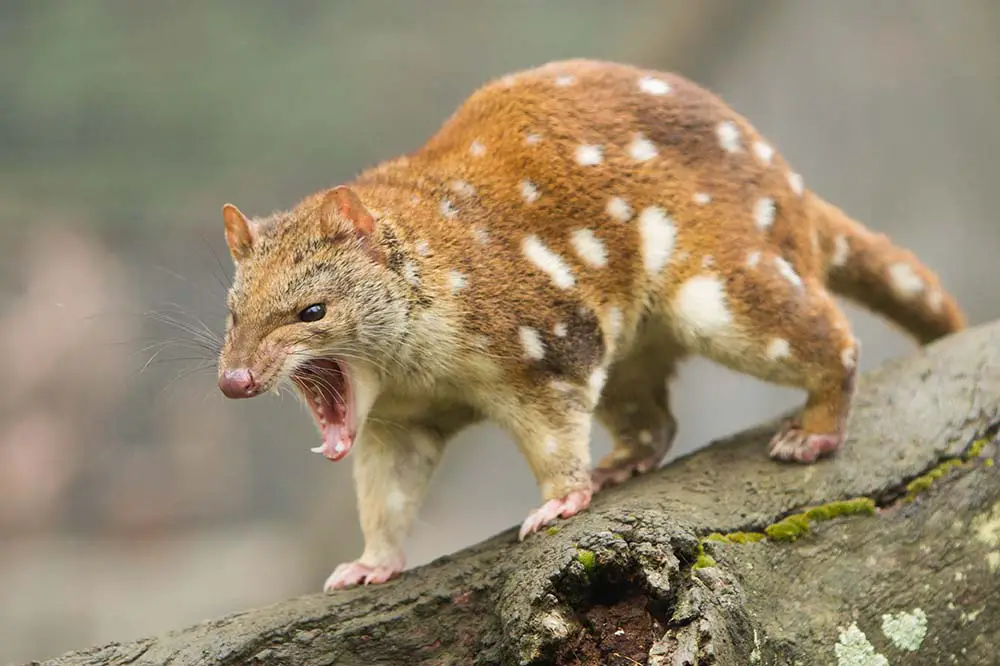
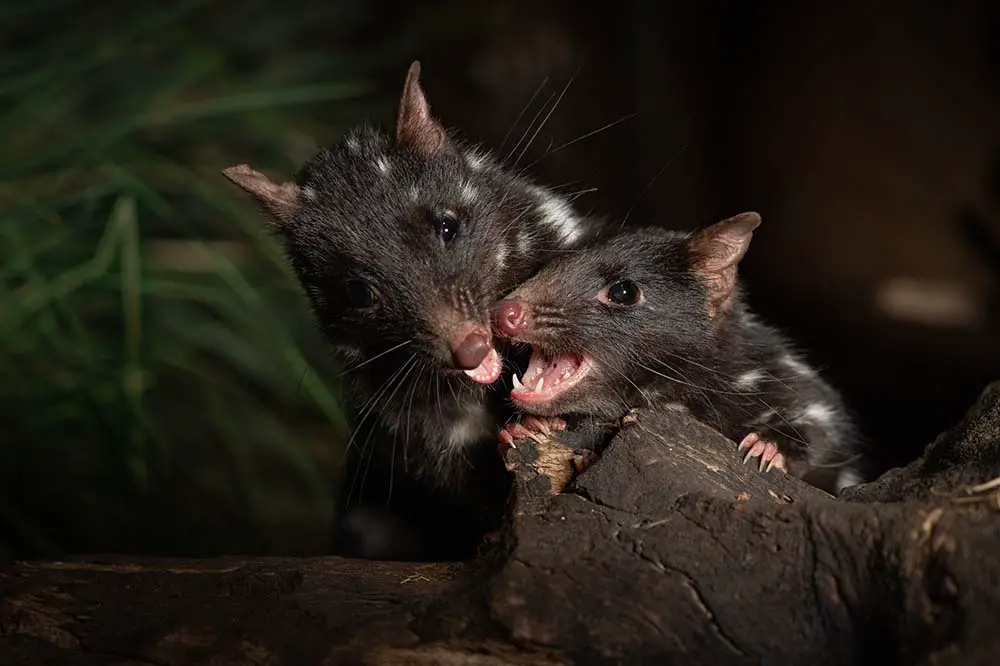
Left: Spotted Quoll Snarling and Showing Teeth | Craig Dingle / Shutterstock & Right: Eastern Quolls in Tasmania, Australia | Wirestock Creators / Shutterstock
The smaller members of Dasyuridae make up the majority of species. The most numerous of these members are 15 species of antechinus and 23 species of dunnart. The Yellow-footed antechinus is tiny (47 g / 1.7 oz). These marsupials have more of a flap than a fully developed pouch. In contrast to the animals previously discussed, the yellow-footed antechinus is diurnal. They are found in a variety of habitats in eastern Australia and also on the southern tip of the west coast.
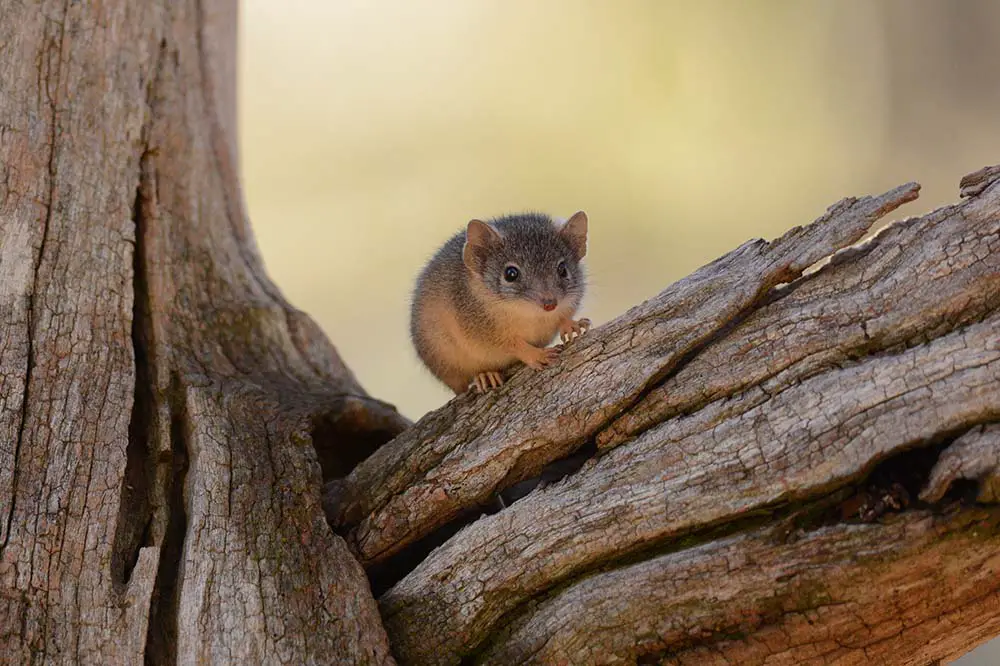
The Fat-tailed dunnart is even smaller averaging just 16 g (0.56 oz); they feed on grasshoppers, moths and beetles. Other miniature members of this family include the slender-tailed dunnart and the southern ningaui which is found along Australia’s south coast.
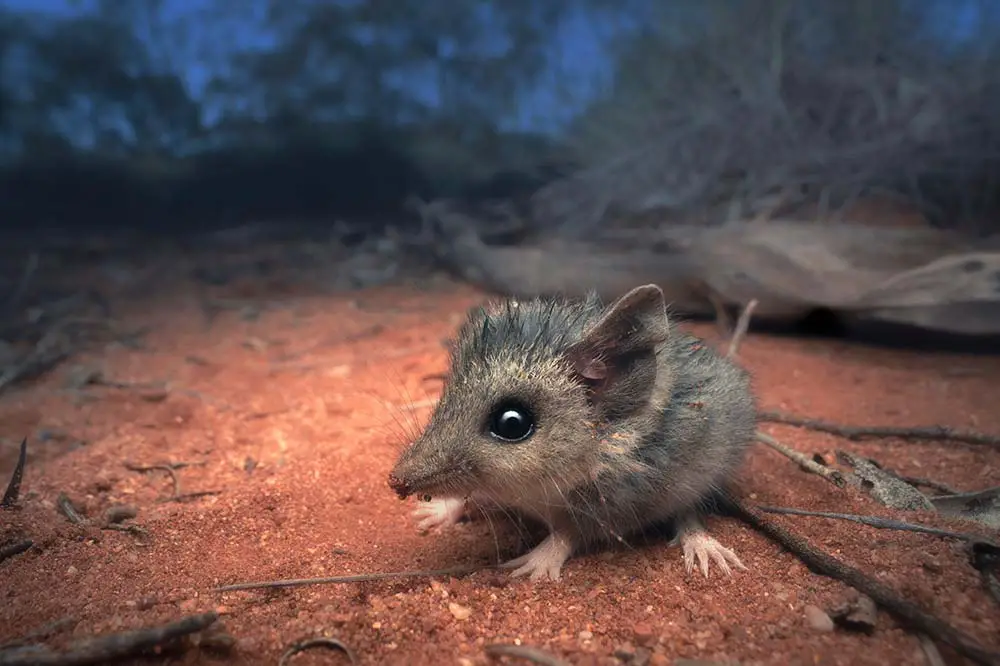
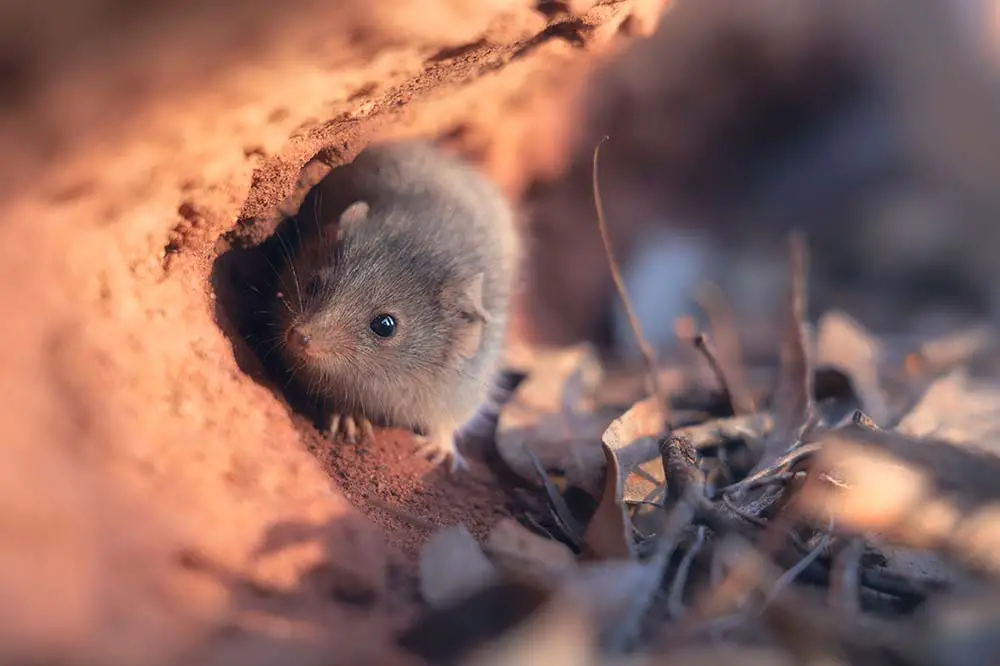
Left: Slender-tailed dunnart | Kristian Bell / Shutterstock & Southern Ningaui | Kristian Bell / Shutterstock
The only other species found in this order is the sole member of the Myrmecobiidae family, the unique and beautiful numbat. Interestingly, these animals are one divergence removed from the now extinct Tasmanian Tiger and share the stripes across their back and rump. Numbats are roughly half the size of an eastern quoll (750 g / 26.5 oz) and are unfortunately listed as endangered. They are found only in a small collection of eucalypt woodlands in southern Australia.
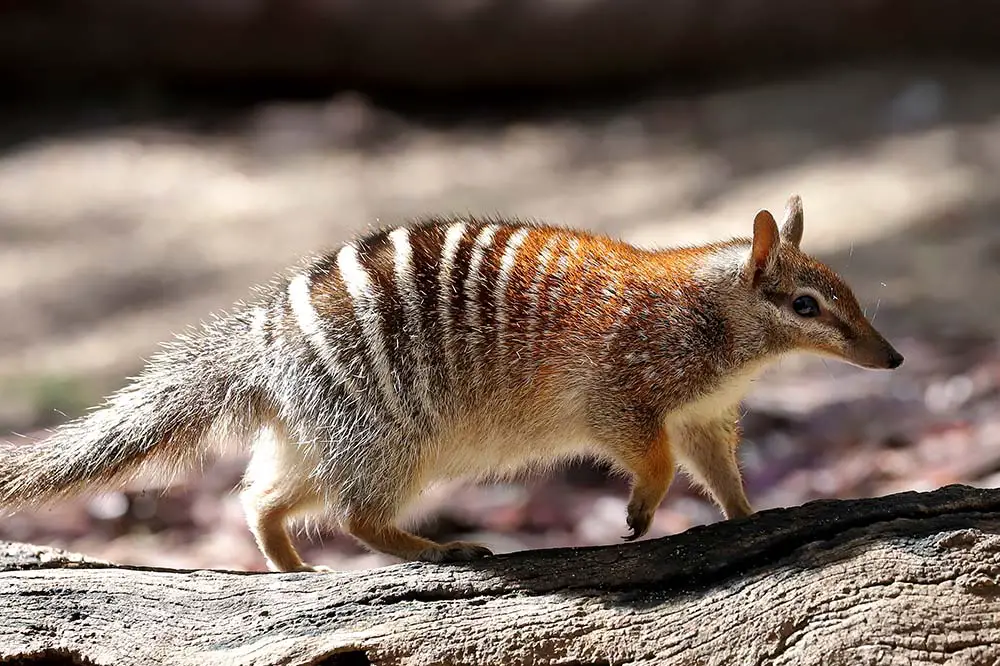
Diprotodontia
The largest and most diverse order inside of Australidelphia is Diprotodontia, which itself contains 3 suborders, 11 families and over 130 species. Diprotodonts have two distinguishing features; Most species have a large pair of incisors dominating their lower jaw bone. They are also syndactylous, meaning the second and third digits of the hind foot are fused up to the claw.
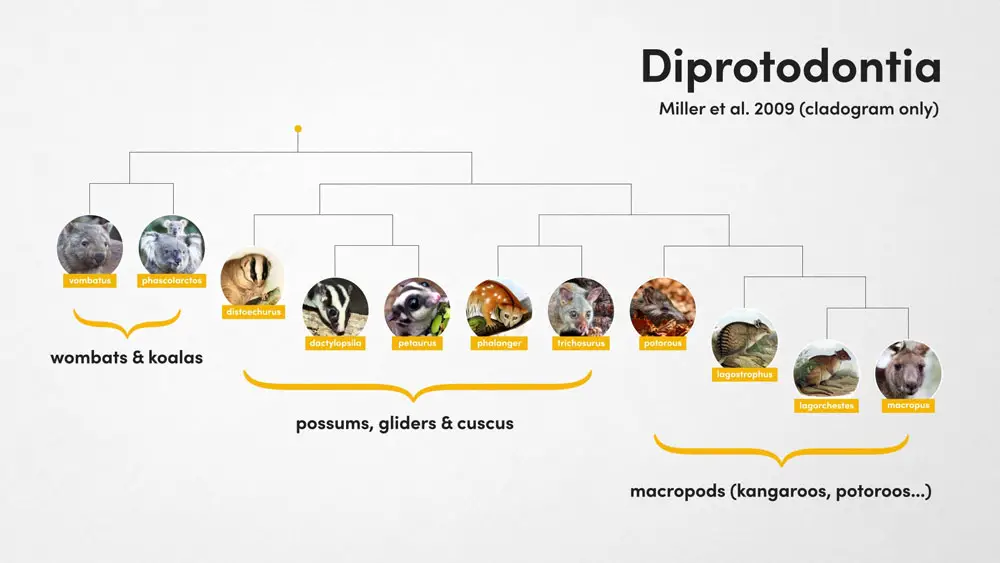
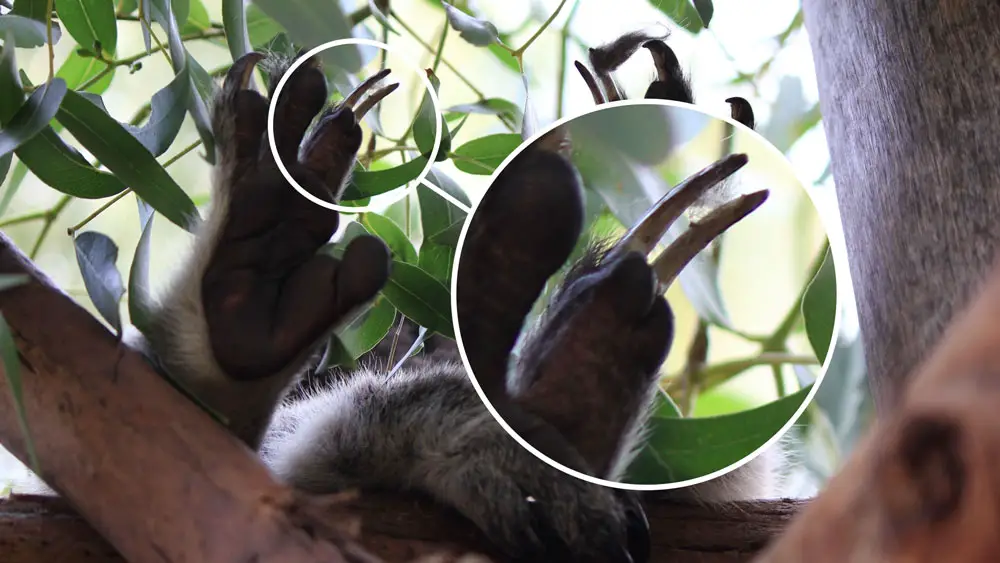
Vombatiformes
The first of the three suborders, Vombatiformes contains the sole species of koala and 3 species of wombat. Koalas weigh no more than around 12 kg (11.8 kg / 26 lbs) and, being arboreal, are found in the eucalyptus forests of Eastern Australia where they snack mostly on eucalypt tree species. They have a gestation period of around 25-35 days, followed by 5-7 months of pouch life. After this period they begin to feed on solid food and are carried around on their mother’s backs. Currently, these loveable creatures have a conservation status of vulnerable.
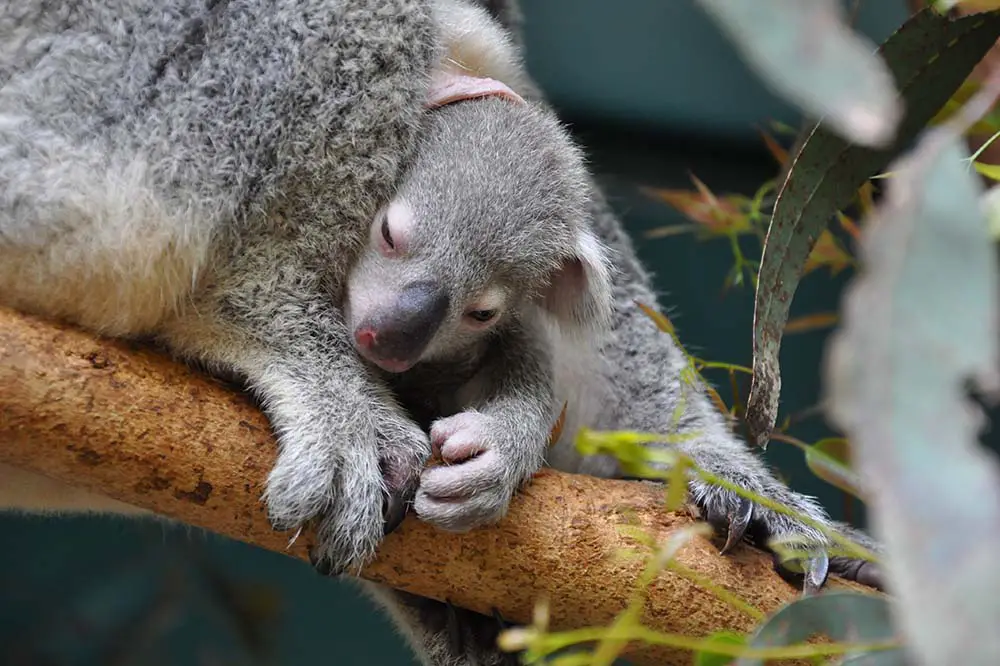
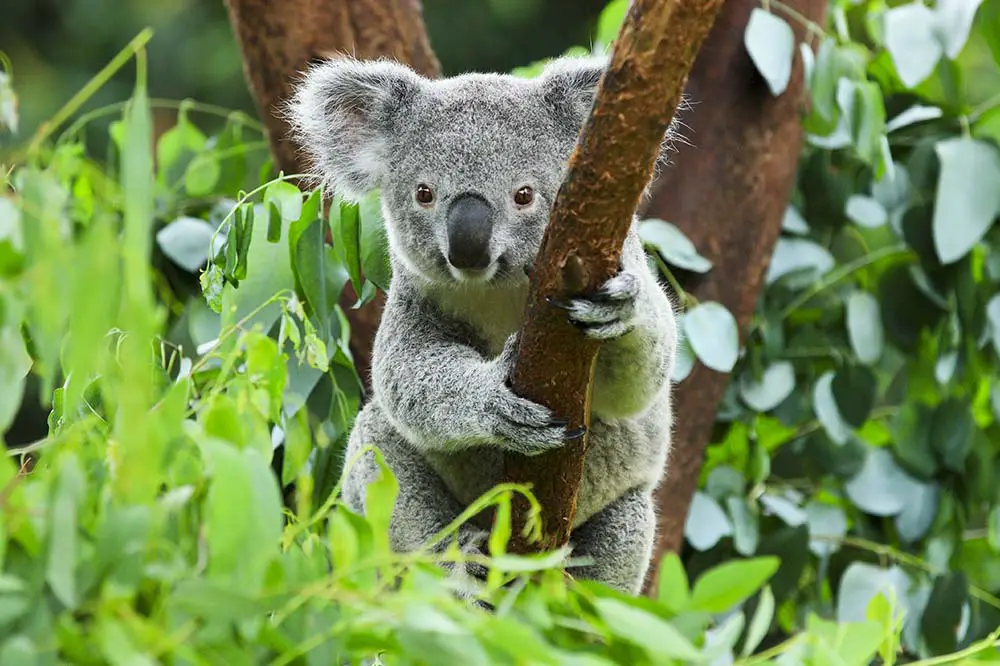
Left: Koala joey emerging from pouch | TeacherKarla / Shutterstock & Right: Koala | rickyd / Shutterstock
The Vombatidae family contains 3 species of wombat; the common wombat and two species of hairy-nosed wombat. They live in underground burrow systems and are generally thought of as solitary but do live in groups called colonies. Like koalas, wombats have compact bodies but grow much larger than their tree-dwelling cousins, with the common or coarse-haired wombat weighing up to three times that of a koala (35 kg / 77 lbs). Gestation and pouch life is almost exactly the same as a koala but because the wombat is fossorial, their pouch opens backwards to prevent dirt from entering while digging. Wombats are found in southern and eastern Australia, with the critically endangered northern hairy-nosed wombat found only in Epping National Forest in Queensland.
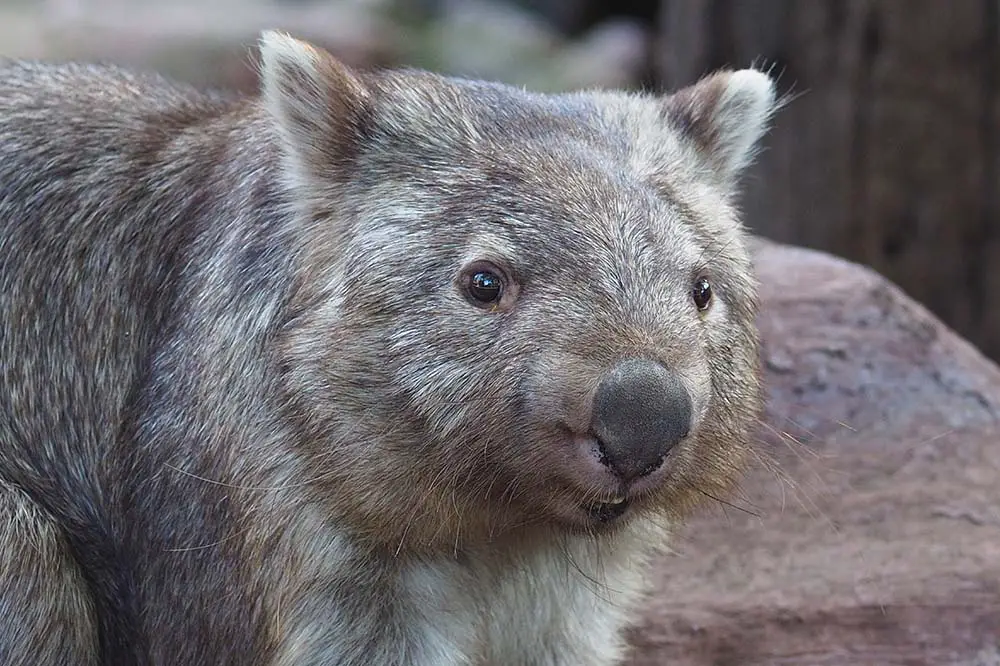
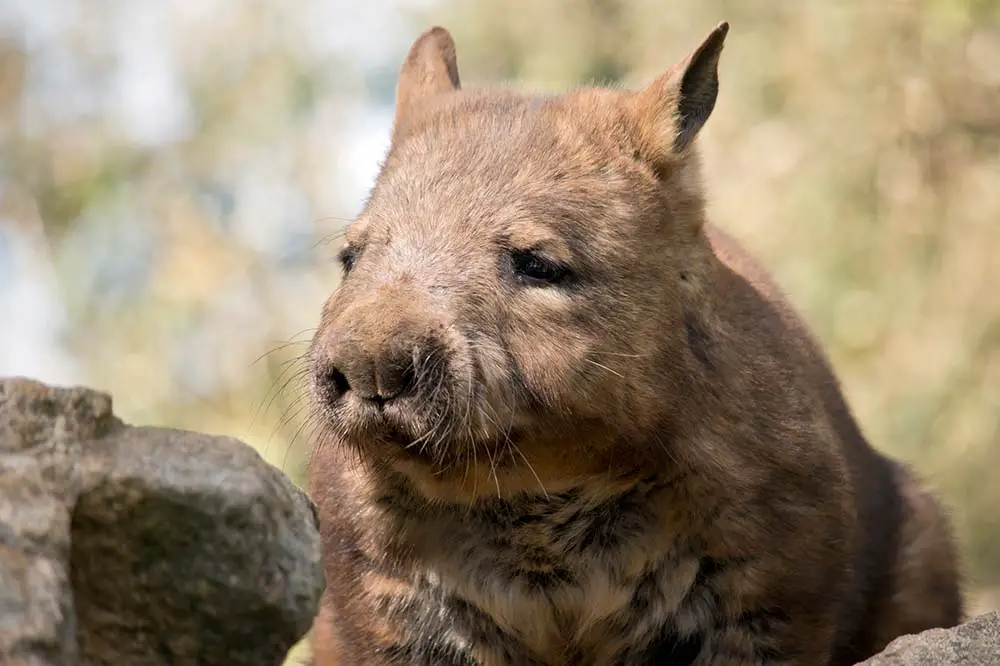
Left: Common wombat | Andreas Ruhz / Shutterstock & Right: Hairy nosed wombat | Susan Flashman / Shutterstock
Macropodiformes
The next suborder Macropodiformes contains 3 families whose members include kangaroos, wallabies, wallaroos, the cheery-looking Quokka and potoroos. Most of these species are found within Macropodidae, a family whose type genus Macropus comes from the Greek words makros (μακρός), meaning long and pous (πούς), meaning foot. There are only two species within Macropus: the western and eastern grey kangaroo. Although the Latin name for the latter is Macropus giganteus, they are not the largest; that prize goes to the red kangaroo who reach up to 90 kg (200 lbs) which also makes them the largest marsupial.
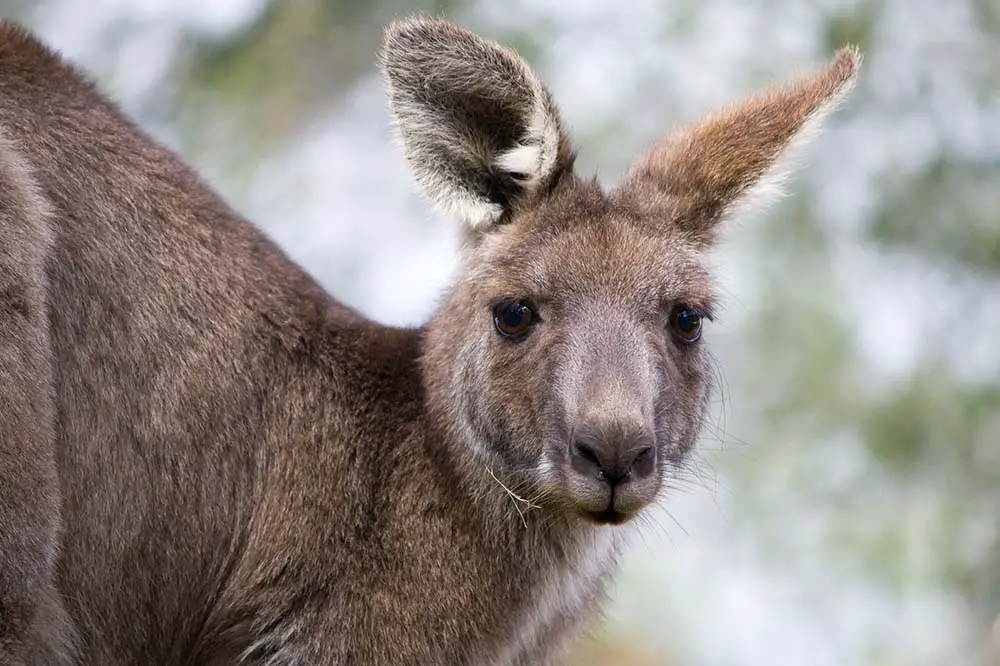
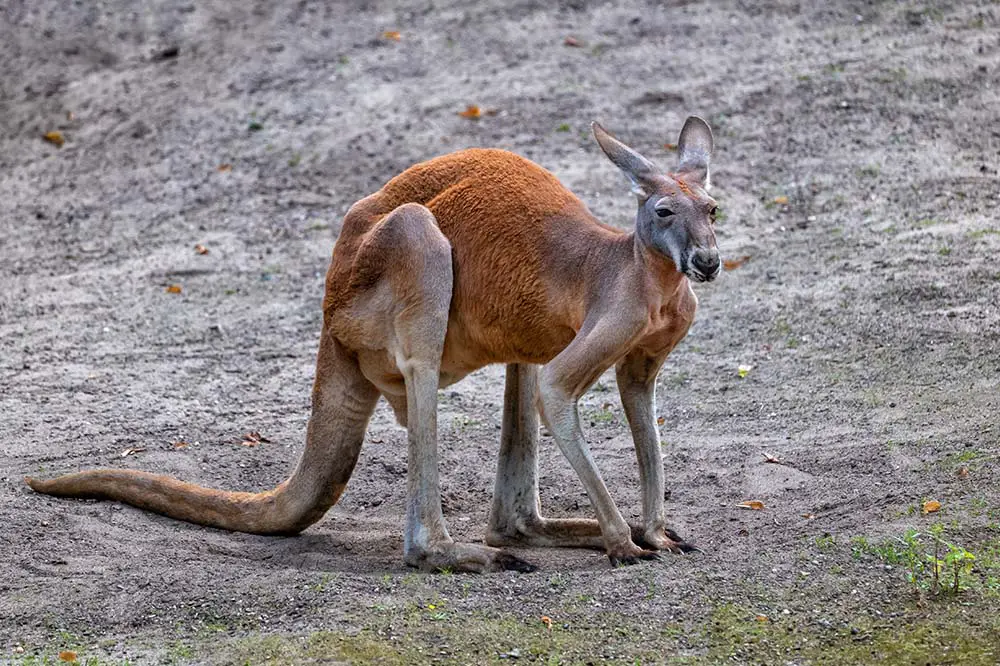
Left: Eastern grey kangaroo | Jarrod Calati / Shutterstock & Right: The red kangaroo | Artur Bogacki / Shutterstock
These animals share their genus with one other member, the Antilopine kangaroo also known as the Antilopine wallaroo, which is quite beautiful and supposedly named so due to their resemblance to the African antelope. The range of these four species differs considerably; the aptly named eastern kangaroo is found to the east, the western kangaroo to the south, Antilopines to the north, and red kangaroos who have the largest range are found in the shrubland, grassland, and desert habitats of inland Australia. The average gestation is a little more than a koala, at just over a month, pouch life can be between 6 to 8 months and joeys will continue suckling up to 18 months depending on the species.
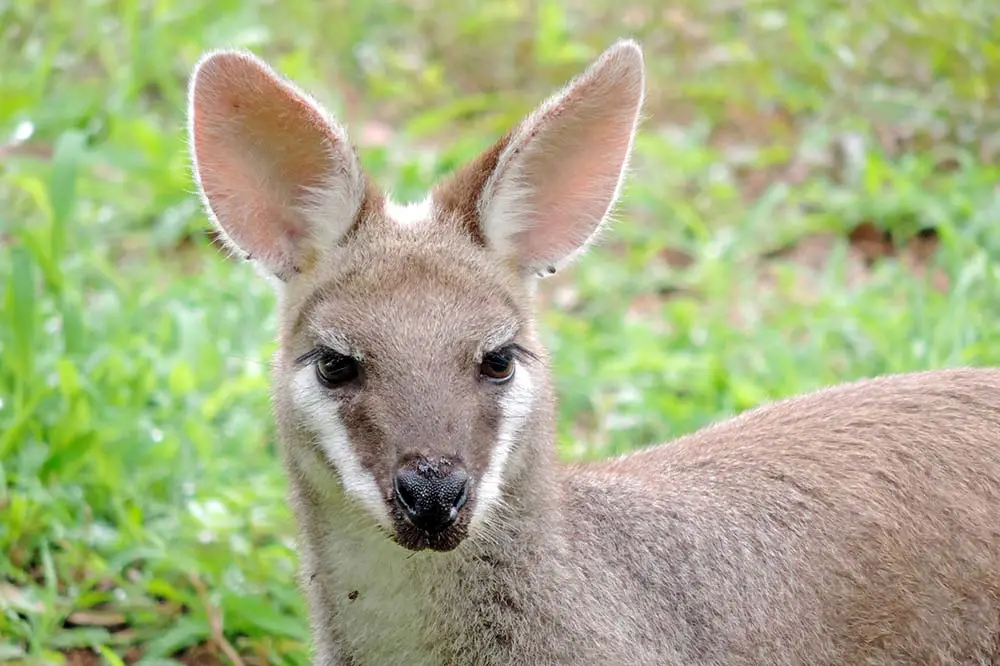
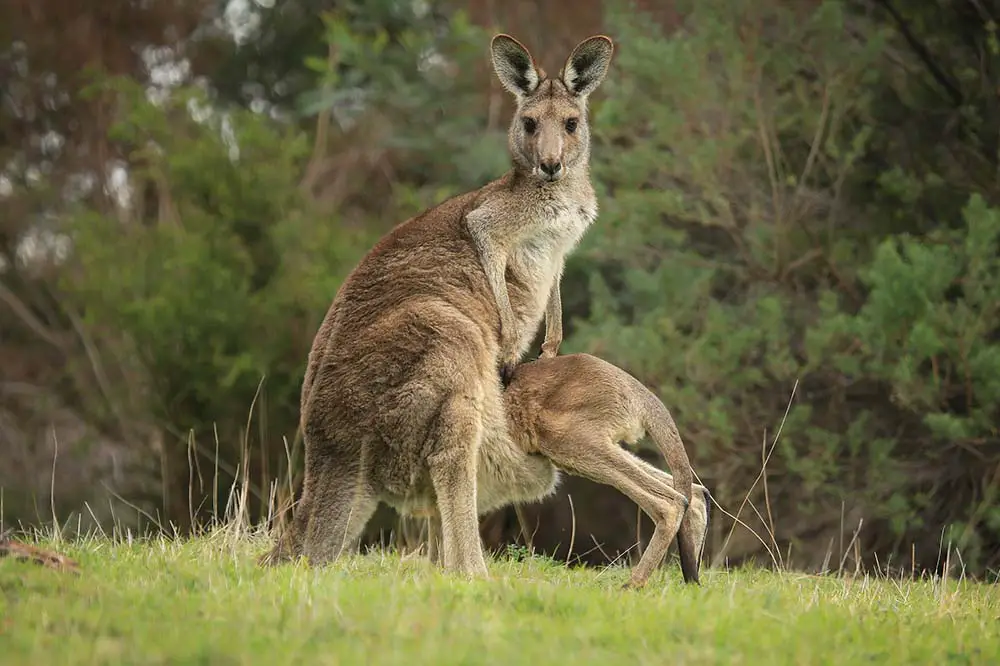
Left: Antilopine kangaroo | Victoria Tucholka / Shutterstock & Right: Female eastern grey kangaroo with joey suckling K.A.Willis / Shutterstock
Wallabies are a group of macropods from various genera that are smaller than the four species of large kangaroo. The red-necked wallaby is one of the most common, they weigh up to 18.5 kg (28.6 lbs) and are named so for the patch of red fur on the back of their neck and shoulders. Like all macropods, these animals are herbivorous and graze on grasses, roots and other foliage. One of the largest groups of wallabies, 17 species to be exact, are found in the Petrogale genus and are known as rock wallabies. These creatures thrive in rocky terrain and exhibit a striking colouration. The Yellow-footed rock-wallaby has a grey back and face with a white belly and stripes and yellow-orange limbs and tail. The Black-flanked rock-wallaby also has white stripes but is much darker and is found dotted around northwestern Australia, in contrast to their yellow-footed friends who are dotted to the southeast. There are also several species of dorcopsis who are thought of as wallabies, such as the white-striped dorcopsis also known as the greater forest wallaby.
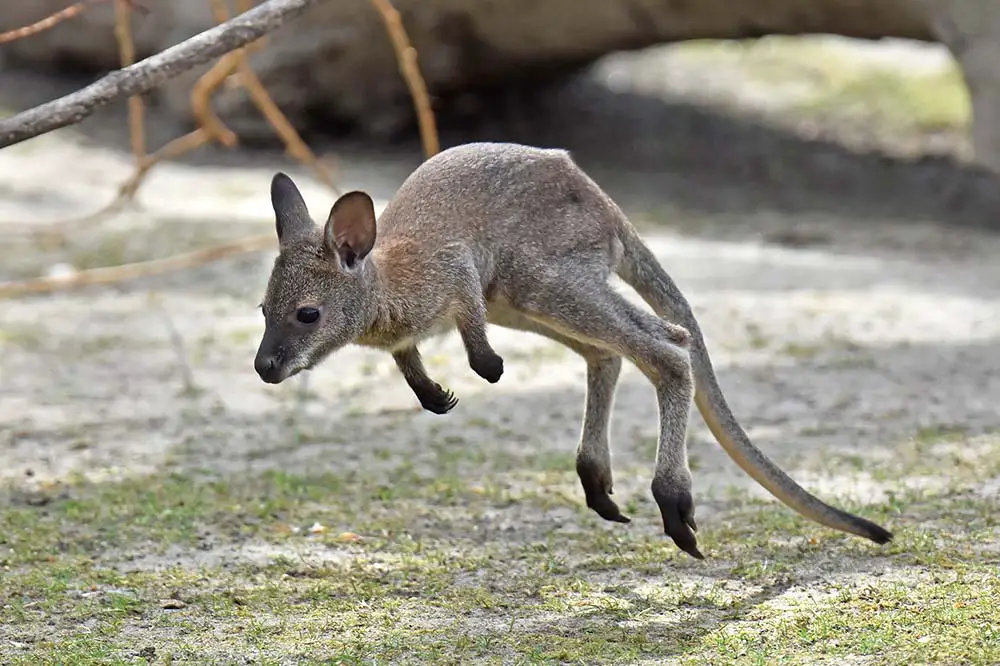
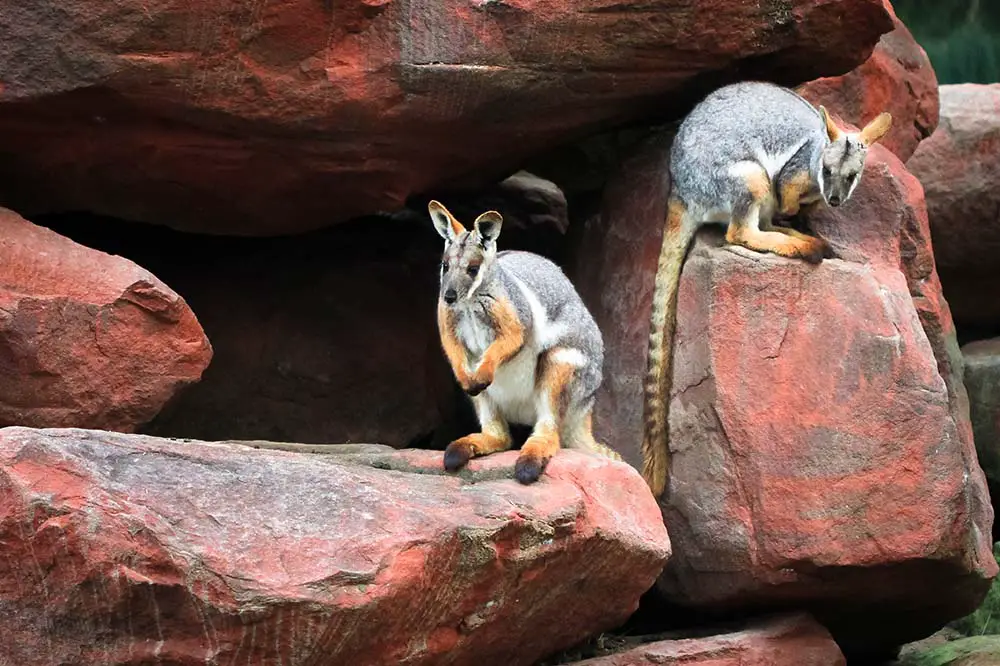
Left: A young red-necked wallaby | Dennis Jacobsen / Shutterstock & Right: A pair of yellow-footed rock-wallabies | Kevin Wells Photography / Shutterstock
It is thought that all macropods once lived in the trees but eventually adapted to life on the ground.
The genus Dendrolagus contains 14 species, all of which returned to a life in the trees, and as such, are commonly referred to as tree kangaroos. 12 of the 14 species live on the island of New Guinea and are among the most threatened of all marsupials with 7 of those 12 classed as endangered or critically endangered such as the Goodfellow’s tree-kangaroo who exhibit a rich reddish-brown and cream coat and weigh no more than 7.5 kg (7.4 kg / 16.3 lbs) and the Matschie’s tree-kangaroo who are a little darker and quite a bit larger (13 kg / 28.63 lb). The remaining 2 species, including Lumholtz’s tree-kangaroo, are found on the northern tip of Australia’s Queensland province and are quite different, exhibiting a much darker coat.
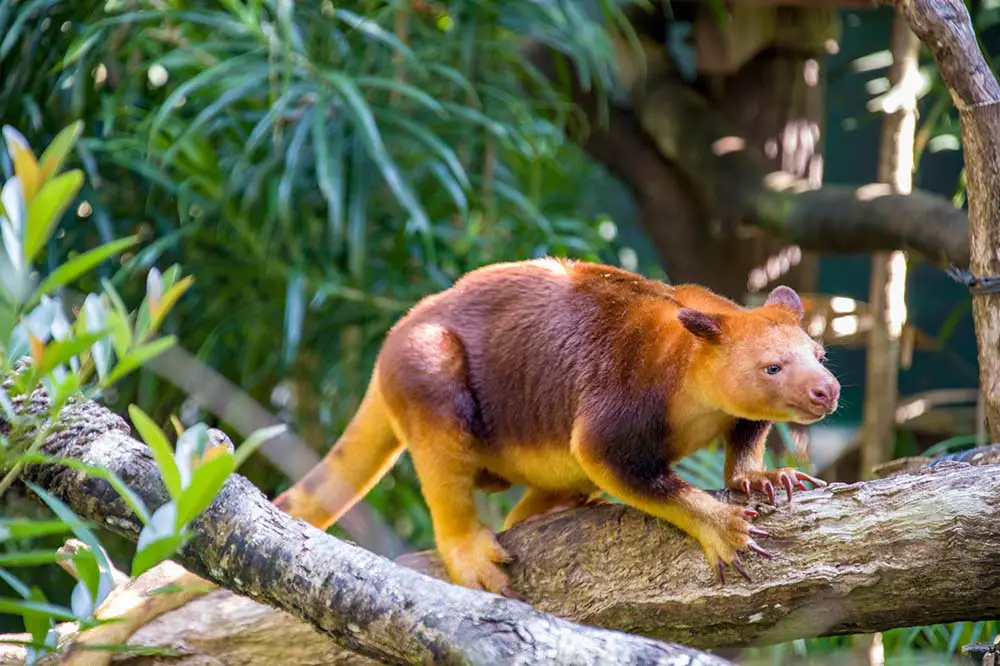
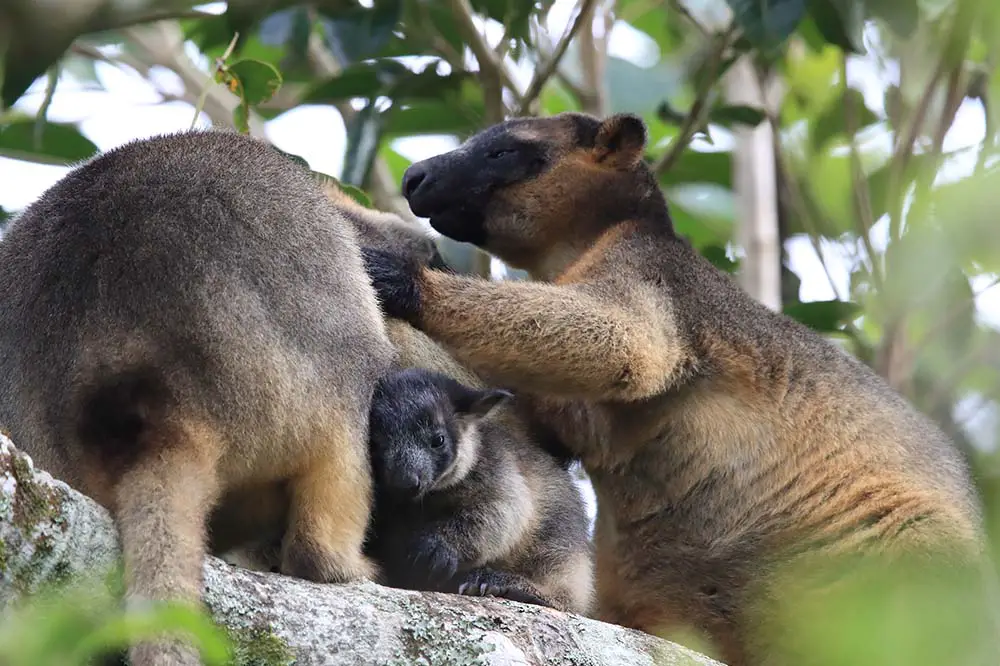
Left: Goodfellow’s tree-kangaroo | Danny Ye / Shutterstock & Right: Lumholtz’s tree-kangaroos with cub | Frank Fichtmueller / Shutterstock
Rounding out Macropodidae, are the smallest members of this family: pademelons and the quokka. All 7 pademelons are found in the same genus Thylogale and like kangaroos have a gestation period of around 30 days and a pouch life of around 6-7 months. Much the same as the red-necked wallaby, the red-necked pademelon has an area of reddish fur on the back of its neck and shoulders. Even smaller still and ostensibly the happiest animal on the planet is the sole member of the monotypic genus Setonix, the quokka. These cheery macropods are about half of a Goodfellow’s tree kangaroo (4.2 kg / 9.25 lbs) and have a slightly shorter gestation period of 26-27 days. They are found on the southwestern tip of Australia where they average around 10 years in the wild. If you thought Macropods couldn’t get any smaller and more charming, I have good news.
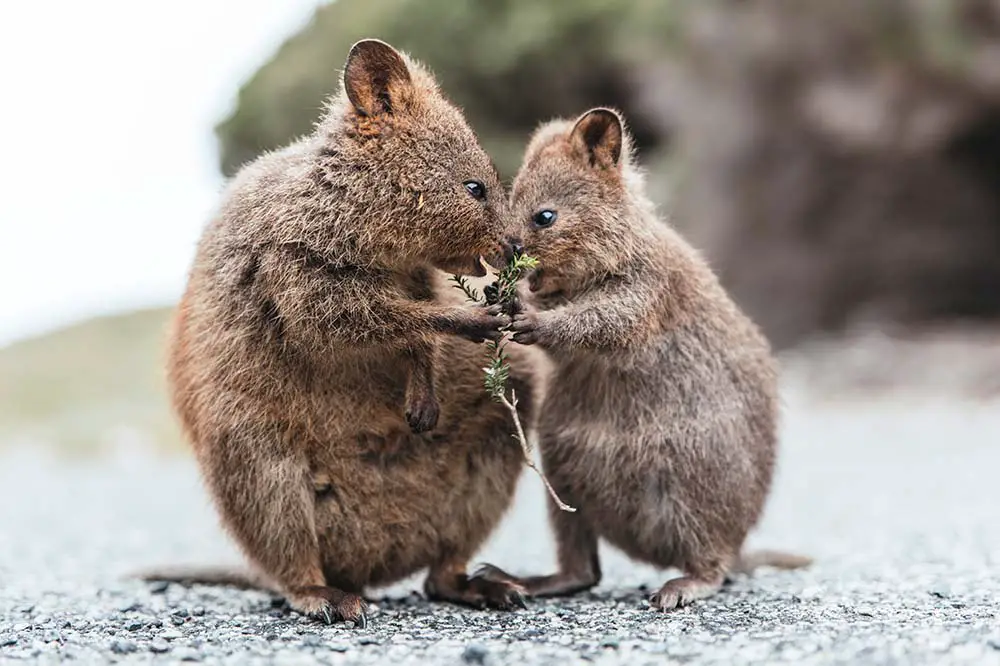
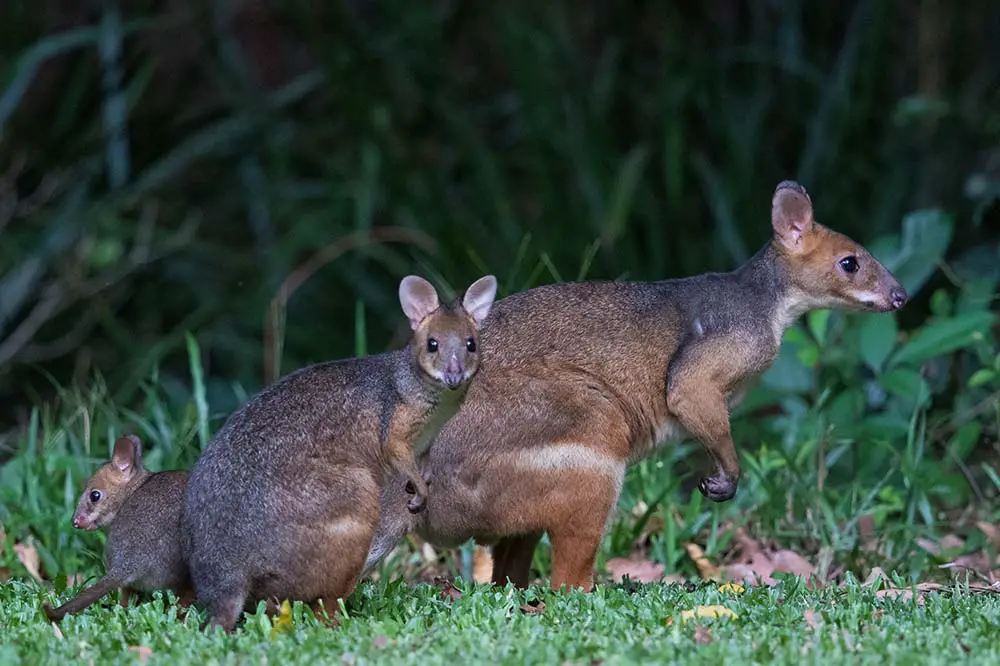
Left: Mother and baby quokka eating twigs | Damian Lugowski / Shutterstock & Right Family of red-legged pademelons | Imogen Warren / Shutterstock
The last two families in Macropodiformes contain its smallest members. Potoroidae contains potoroos, bettongs and rat kangaroos, which are all of a similar size and appearance. The long-nosed potoroo weighs no more than 2 kg (1.8 kg / 4 lbs) and has a longer gestation period than regular kangaroos at around 38 days but a shorter pouch life with joeys staying in the marsupium for around 130 days or a little under 4.5 months. The Eastern bettong, also known as the Tasmanian betting, is found in grasslands, woodlands and eucalypt forests of eastern Tasmania. They are nocturnal and up to 80% of their diet can be made up of fungi, which is foraged with its little forelimbs. The rufous bettong, also known as the rufous rat-kangaroo, is quite a bit larger, weighing around twice that of the long-nosed potoroo (3.6 kg / 8 lbs). The final macropod we’ll look at is the sole extant member of Hypsiprymnodontidae, the musky rat-kangaroo. They are quite a bit smaller (500g /1.1 lbs) and much darker in colour.
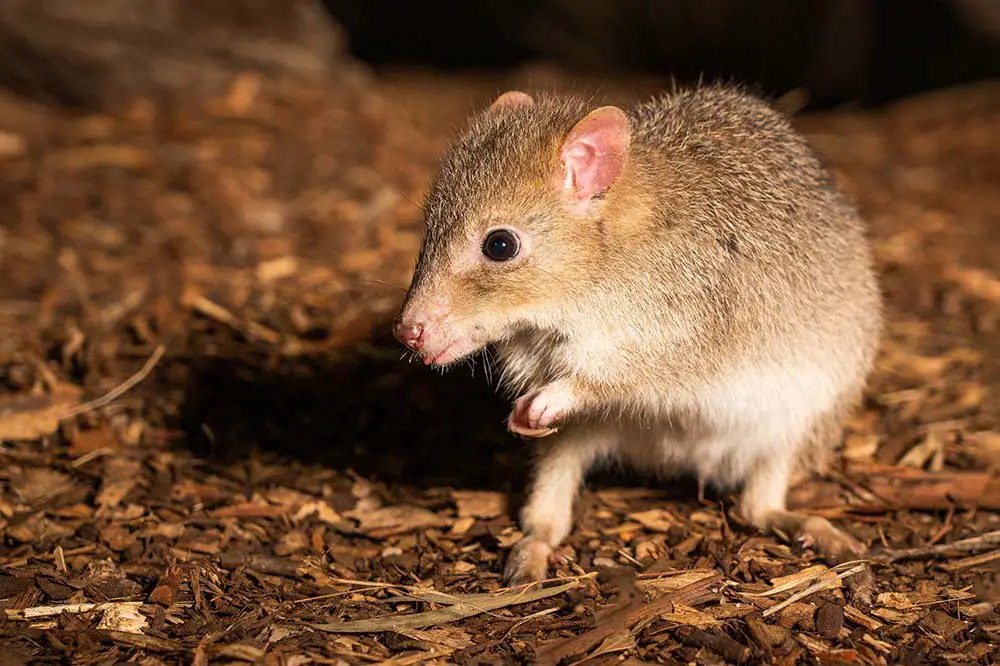
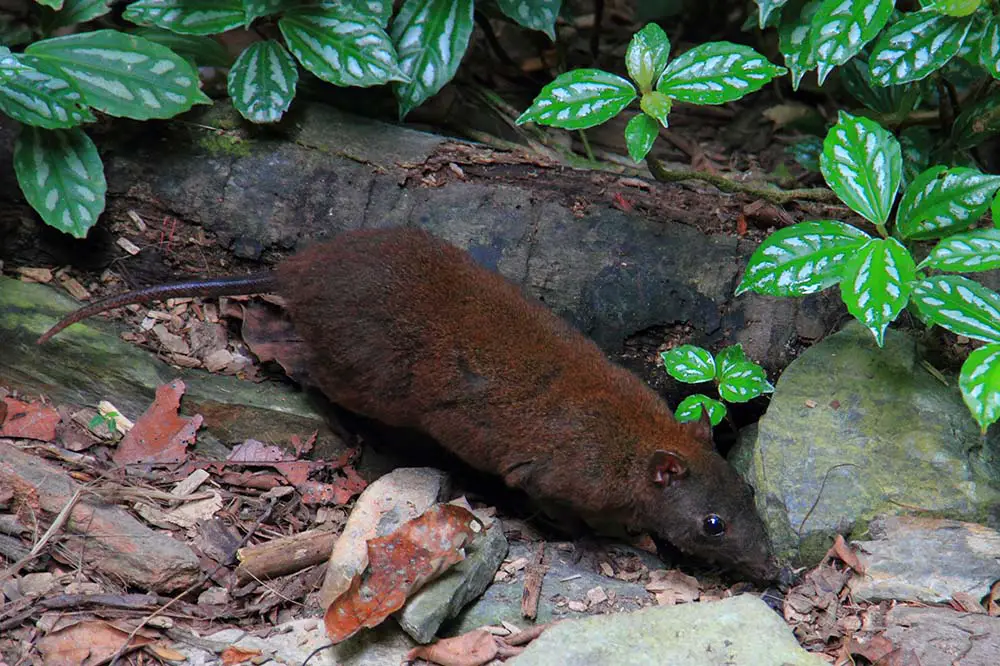
Left: Eastern bettong | Wirestock Creators / Shutterstock & Right: Musky rat-kangaroo | feathercollector / Shutterstock
Phalangeriformes
Phalangeriformes is the last suborder within Diprotodontia and contains a unique set of arboreal marsupials grouped into 6 families that contain a mixture of gliders, possums and cuscuses. Unlike macropods which are bipedal, the members of Phalangeriformes are quadrupedal, bearing weight on all four of their limbs. The gliders of this suborder have also evolved flaps of skin between their limbs on either side of their bodies that they use to glide up to 65ft through the canopy. Although the name possum is derived from North American opossums due to their resemblance in appearance, they are not closely related.
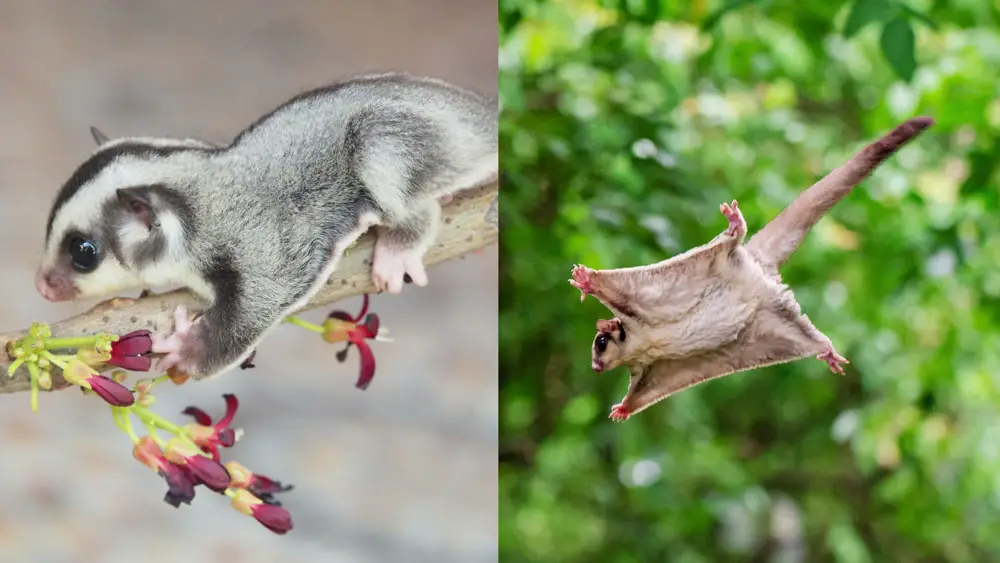
Petauridae is the first family we’ll explore, it contains various species of striped possum, most of which are found on New Guinea and gliders, which are mostly found in Australia, although there is some crossover between the two. The sugar glider is a well-known member of this family and has quite a large range, being found on both the northern and eastern coast of Australia and New Guinea. Sugar gliders are tiny, weighing only 100 g (3.9 oz) and at 16 days, their gestation period is significantly shorter than the species previously discussed. Pouch life is a little over 2 months and they become independent not long after that. The average number of offspring is two and their average lifespan in the wild is 14 years. The Yellow-bellied glider is another species found on the east coast of Australia. The striped possum has a similar appearance to a sugar glider but is around 5-6 times the size (570 g / 20 oz). They live in lowland tropical forests and woodlands where being insectivores, will prey on ants, termites, beetles and moths.
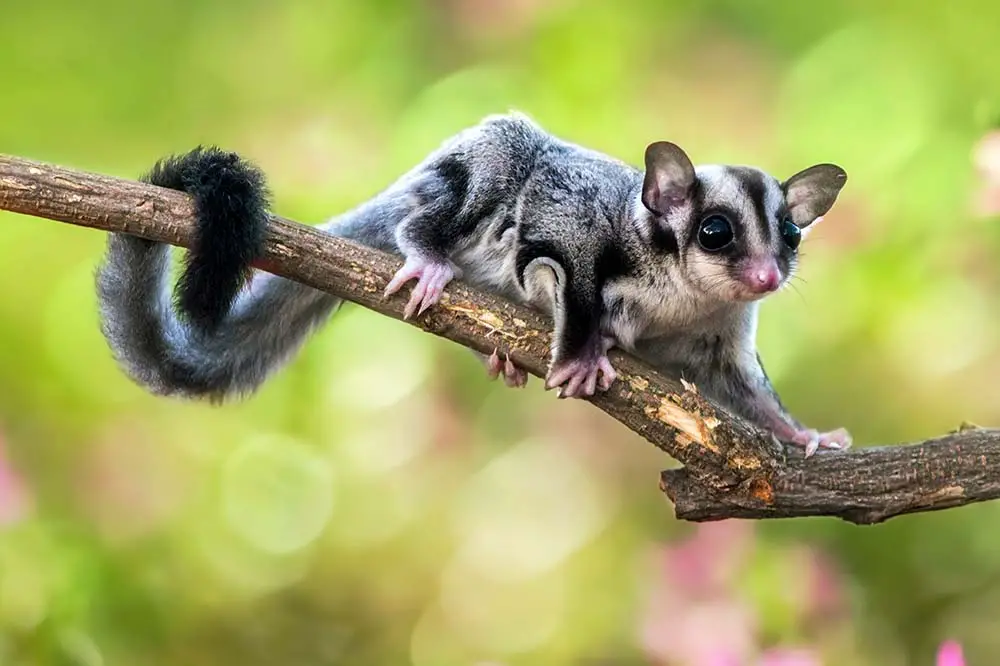
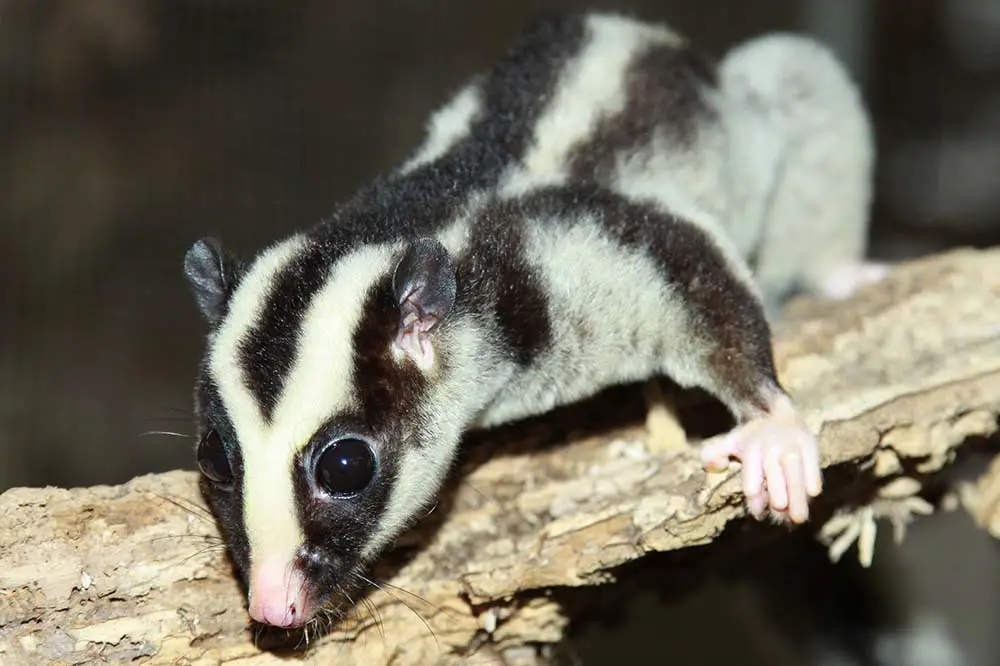
Left: Sugar Glider | Arif Supriyadi / Shutterstock & Right: Common striped possum | Michal Sloviak / Shutterstock
Phalangeridae is a large family containing 22 species of cuscus and 5 species of brushtail possum.
The Waigeo cuscus is one of the most unique-looking marsupials on this list. They are named after Indonesia’s Waigeo island found to the northwest of New Guinea and displays a white pelage with black spots and a red face. The Sulawesi bear cuscus is quite different with a much darker fur and is found further west on the Indonesian island of Sulawesi. They weigh around 7 kg (15.5 lbs) and are classified as a folivore, an animal that primarily feeds on leaves although they will also eat unripe fruit, flowers and buds. Found in the same family but a different genus, the common brushtail possum has a much larger range being found throughout much of coastal Australia and was also introduced to New Zealand in the 1840s. They range in colour based on location, with some exhibiting a grey coat, some displaying a red pelage and can also be found in a darker black. Their gestation period is around 16-18 days and will remain in the pouch for 4-5 months and will then ride on its mother’s back until around 7-9 months old.
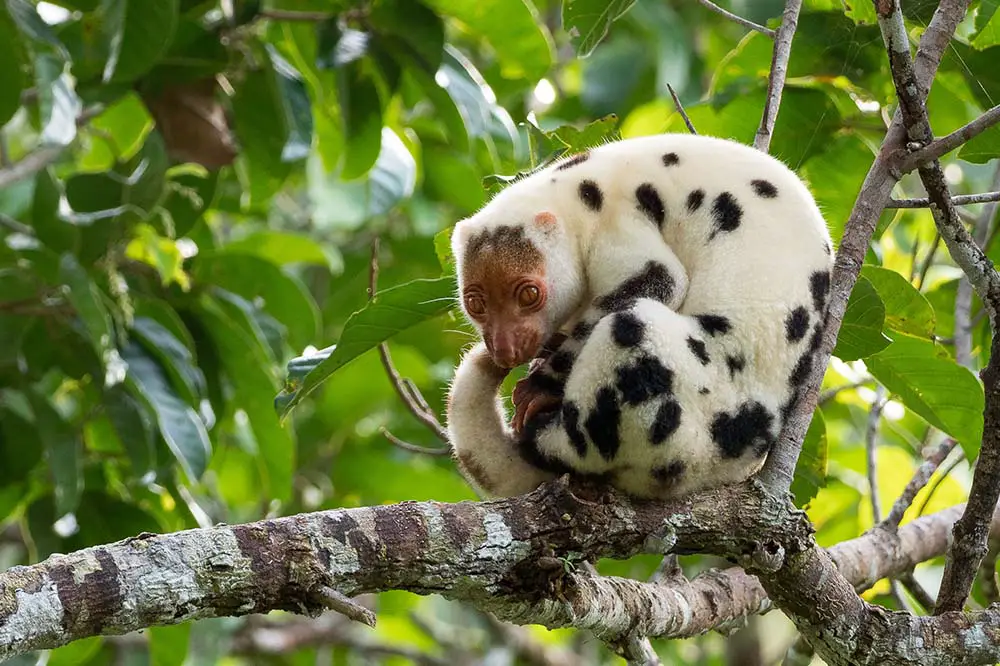
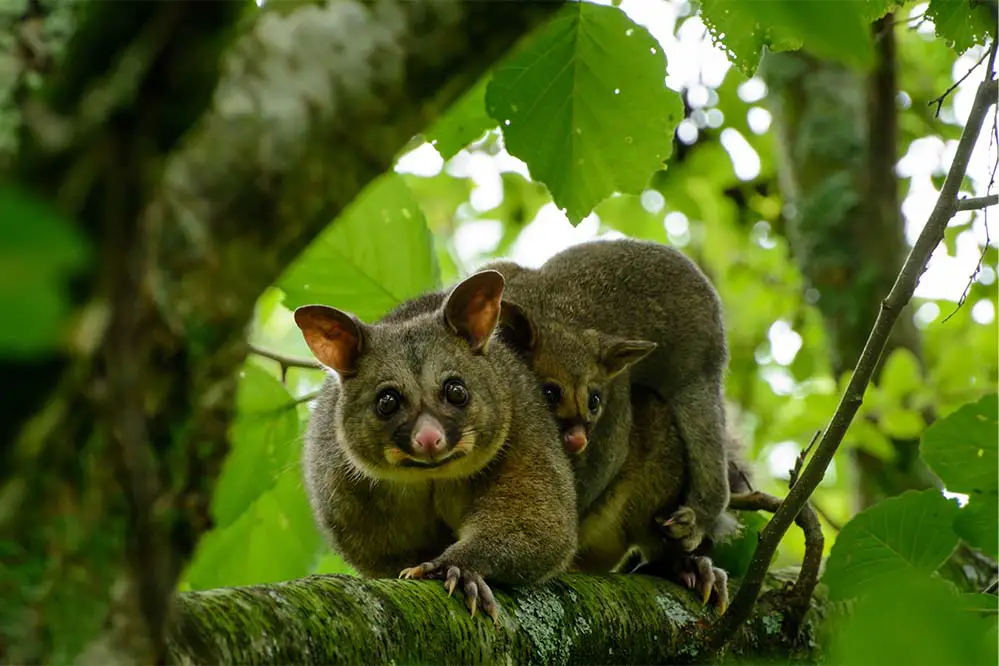
Left: Waigeo spotted cuscus | Arie de Gier / Shutterstock & Right: Common brushtail possum | Lowell Hendrix / Shutterstock
Pseudocheiridae contains 16 species of ringtailed possums and 3 species of glider. They were previously classified as part of Petauridae but were found to differ by dental structure. The members of this family, which include the southern greater glider, are some of the largest gliders at roughly the same size as a domestic cat and can be found in a range of colours from pure black to white, red and yellow. Around the same size, the common ringtail possum has a prehensile tail, which it uses in the trees. Families can be found in nests called dreys, which they construct with bark, twigs and ferns. The Green ringtail possum is also part of this family, it is found only in a small area of the northeastern coast of Australia and exhibits a unique fur pattern with a grey face with white rings around the eyes and ears and a green back.
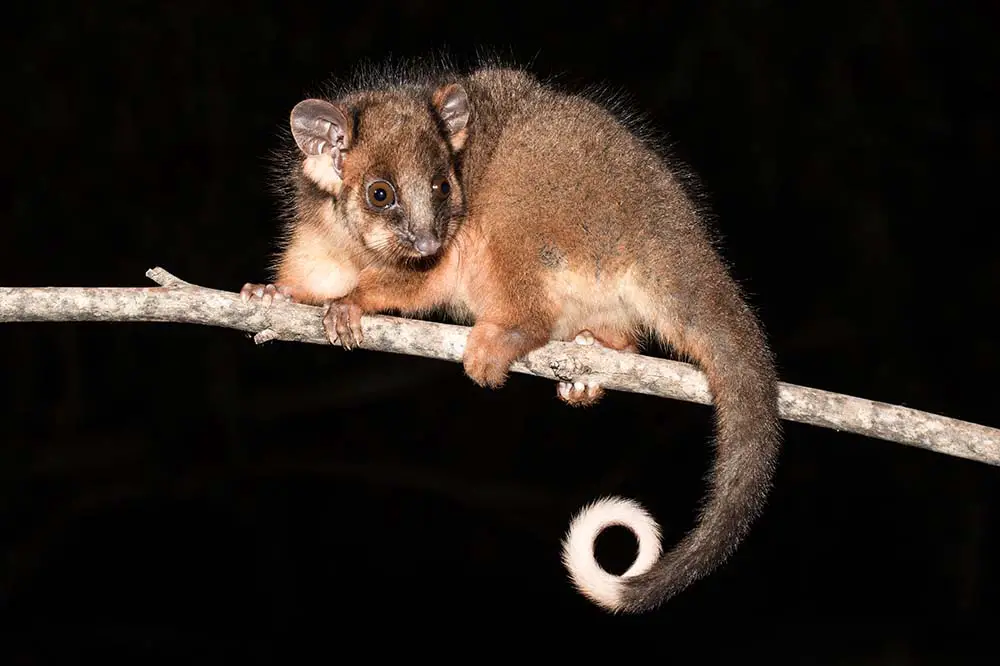
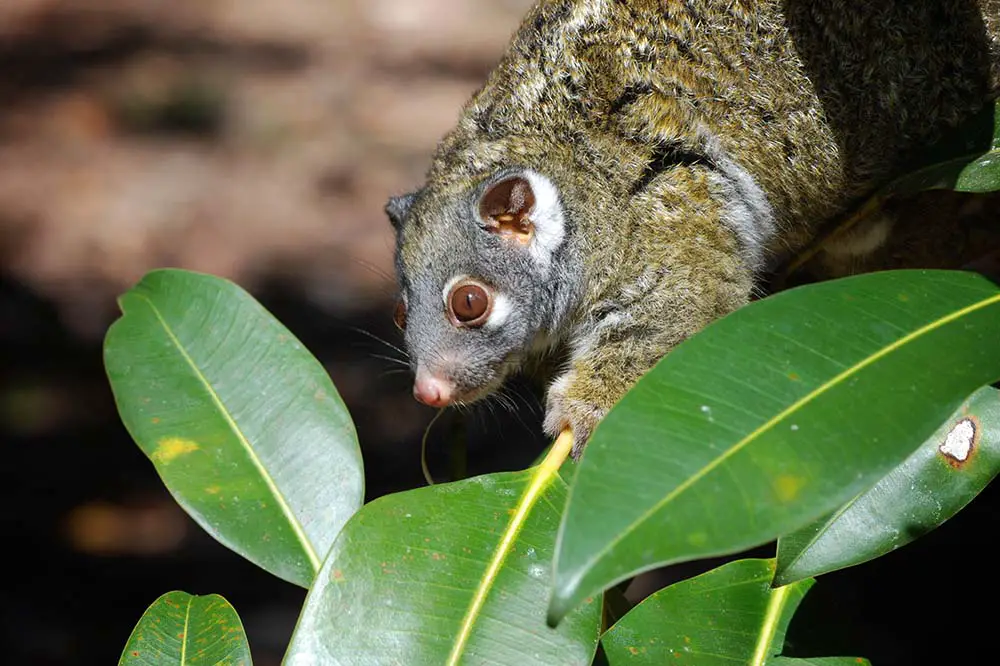
Left: Common ringtail possum | Ken Griffiths / Shutterstock & Right: Green ringtail possum | gillougribouille / Shutterstock
The 5 species of adorable pygmy possum are all contained within the Burramyidae family. They are omnivorous, feasting on both nectar and pollen from plants and a selection of invertebrates. The eastern pygmy possum is found both on the southeastern coast of Australia and Tasmania, whereas the Tasmanian pygmy possum is located mainly in Tasmanian but also a small section of the south coast. The honey possum is the sole member of the Tarsipedidae family, they are found on the southwestern coast of Australia and weigh no more than 18 g (0.63 oz). Acrobatidae is a similarly small family with only two species. The feather-tailed glider is found on the east coast of Australia and is even smaller at a maximum of 13 g (0.46 oz).
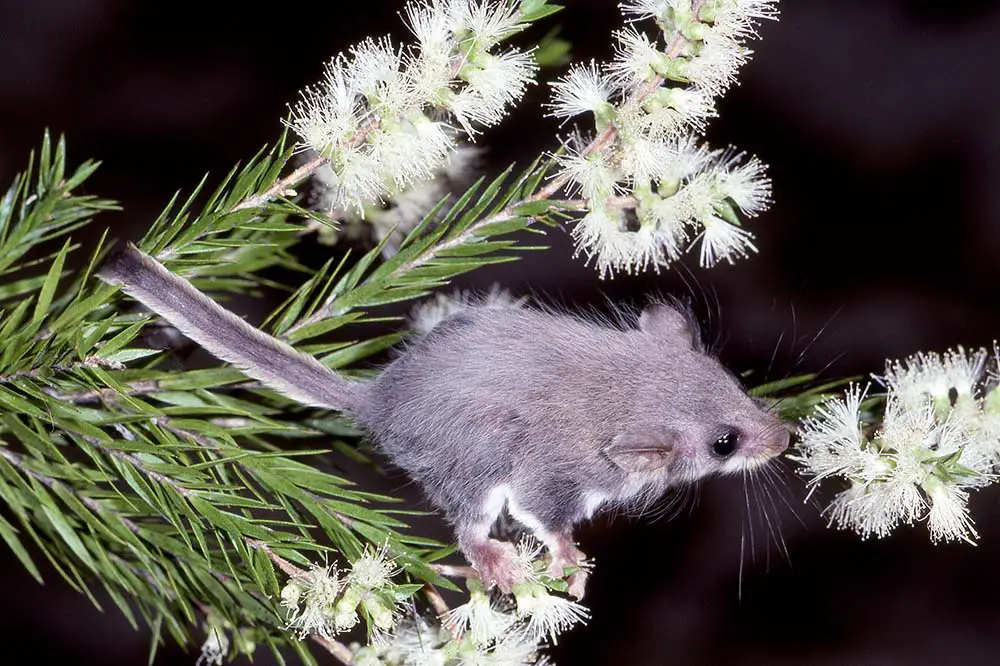
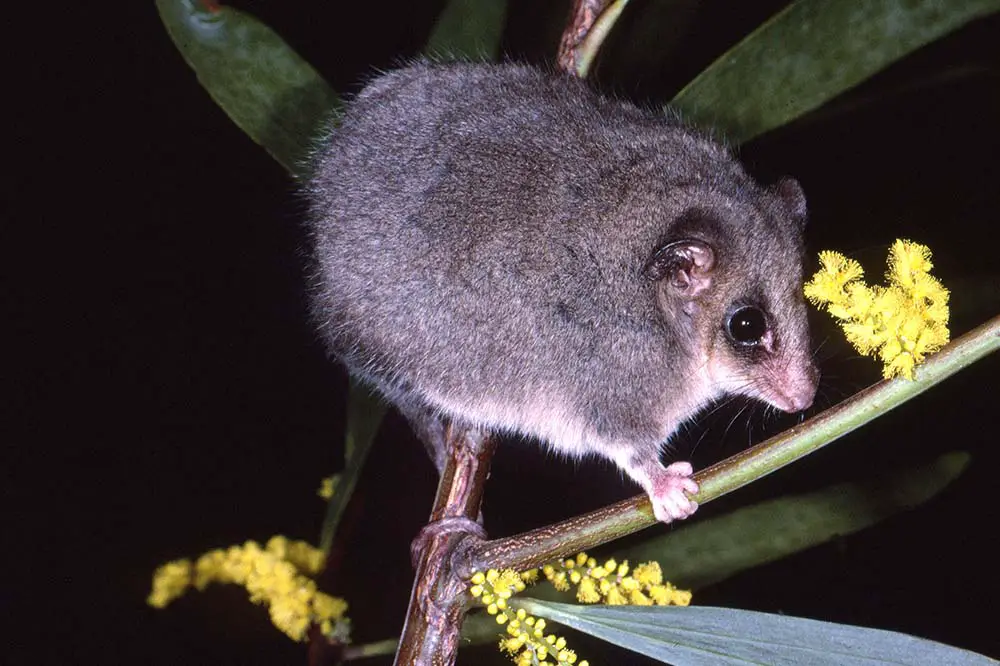
Left: Feather-tailed glider | Ken Griffiths / Shutterstock & Right: Eastern pygmy possum | Ken Griffiths / Shutterstock
Notoryctemorphia
The order Notoryctemorphia contains just two species of marsupial mole but what they lack in number they more than make up for in quirkiness! These odd-looking creatures resemble moles and with their large claws are well-adapted for digging in the sand dunes and sandy soil areas in which they live. Not a great deal is known about these solitary creatures but we do know they consume insects and small lizards as well as some plant matter.
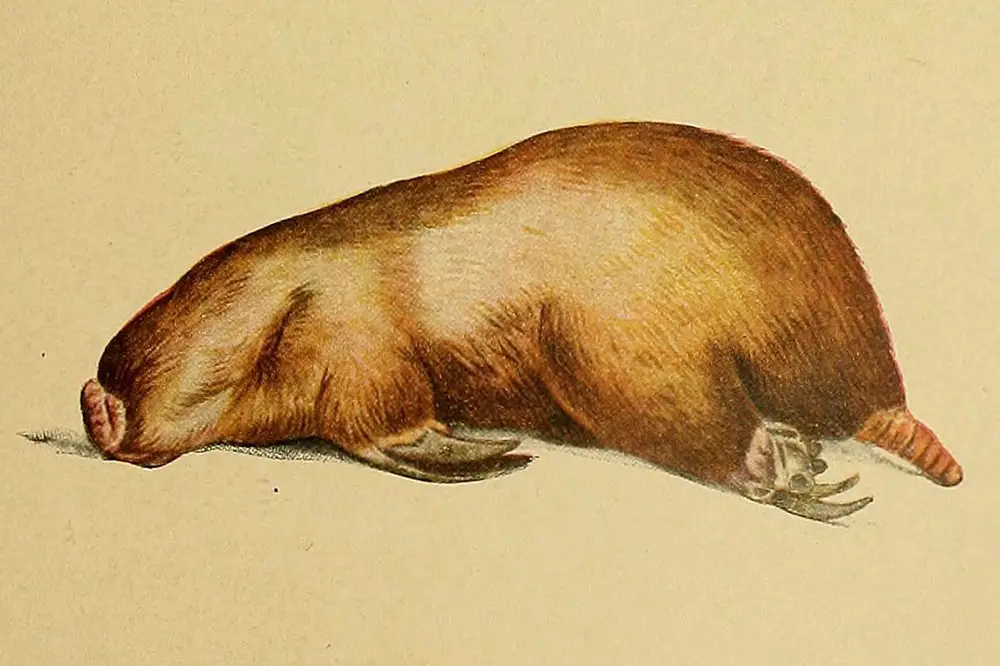
Peramelemorphia
Peramelemorphia is the second to last order we’ll discuss in Australidelphia and the last whose members are located in Australasia. It contains two families, Peramelidae, which contains all extant bandicoots and Thylacomyidae, which contains bilbies, also known as rabbit-bandicoots. Like diprodonts, Bandicoots are also syndactylous and, in similar fashion to a wombat, their pouches open backwards to prevent dirt from entering when digging. The southern brown bandicoot is found on the southern coast of Australia and Tasmania and the long-nosed bandicoot, which has an elongated snout is found along the east coast. The greater bilby or the rabbit-eared bandicoot looks quite different, with its long stiff ears and weighs almost double at 2.5 kg (88 oz).
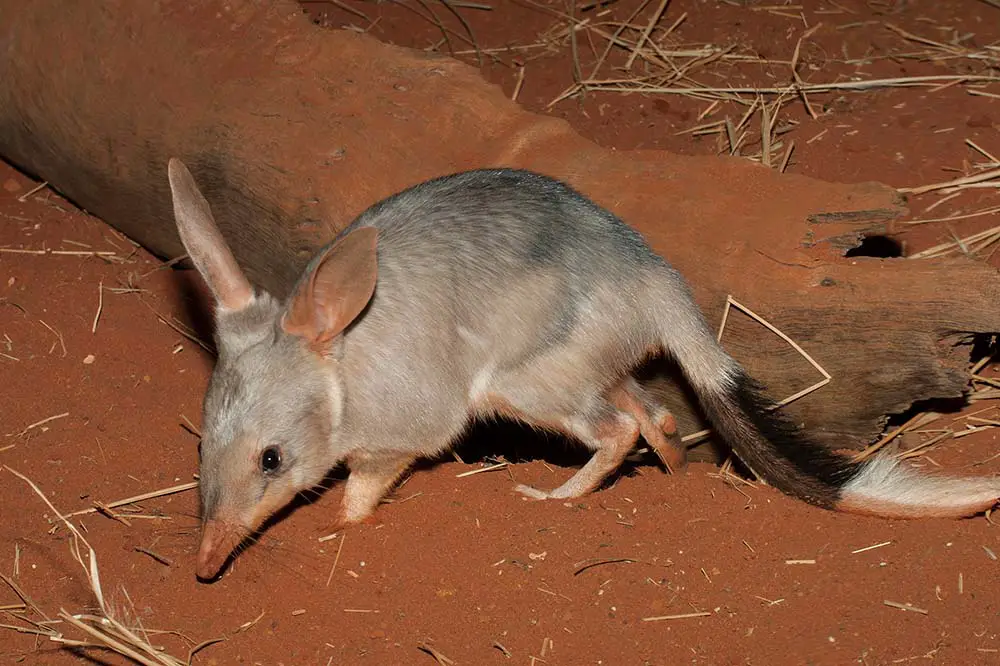
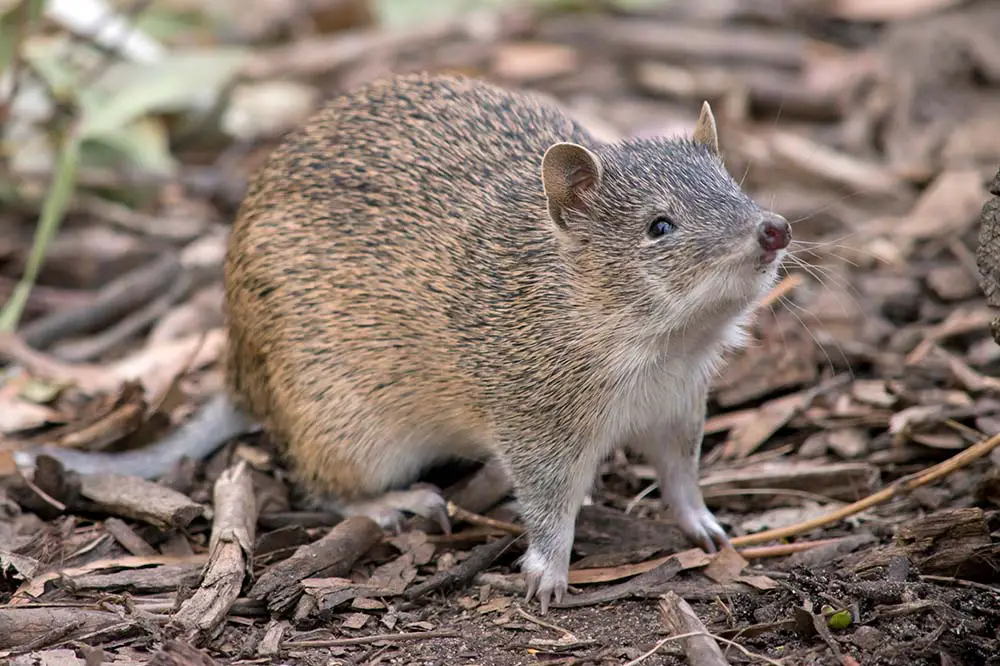
Left: Bilby | Ken Griffiths / Shutterstock & Right: Southern brown bandicoot | Susan Flashman / Shutterstock
Microbiotheria
The order Microbiotheria is the only order in Australidelphia whose members are located in the Americas. It contains just one species, the colocolo opossum, also known as the Monito del monte, which translates from Spanish to “Little monkey of the mountain”. They are found in temperate and tropical forests at elevations up to 1135m / 3723 ft.
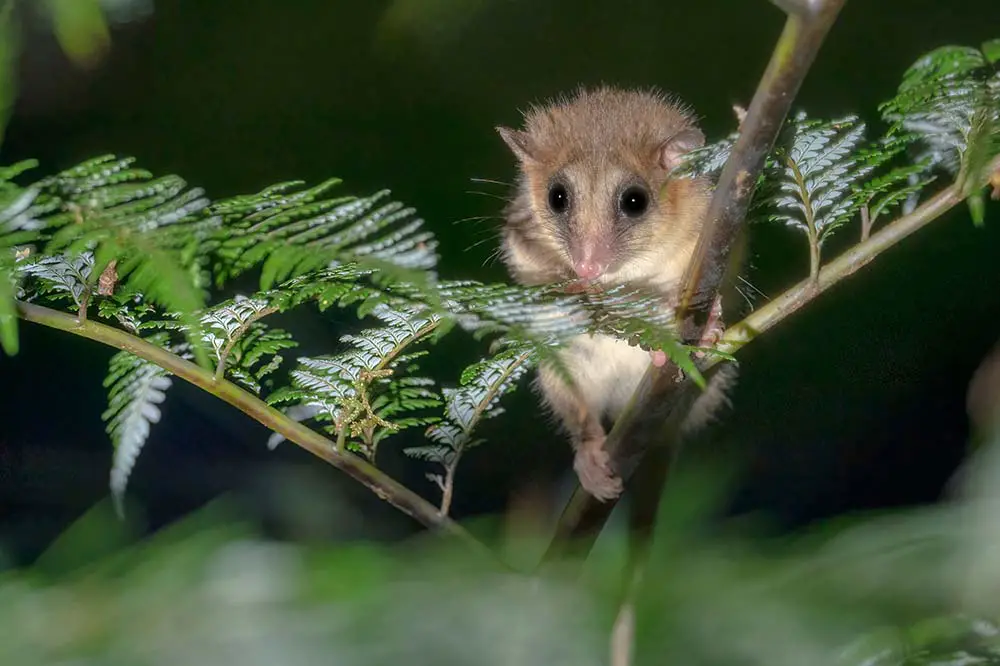
Paucituberculata
The Gray-bellied shrew opossum is one of 7 species of shrew opossum in the order Paucituberculata that bridge the gap nicely to the final but by no means least interesting chapter… opossums.
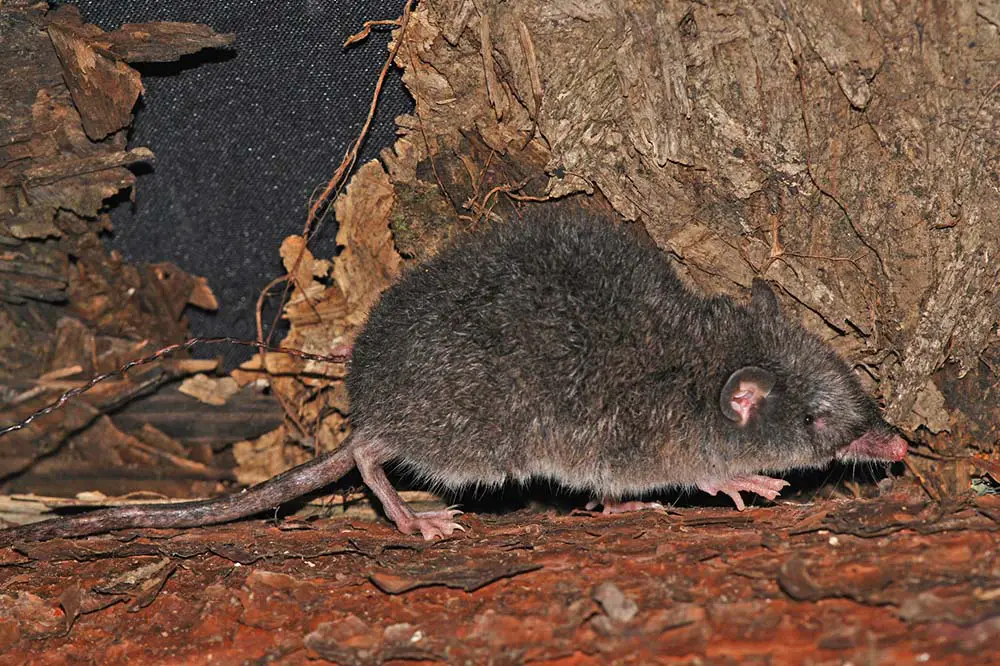
Didelphimorphia
Pictured below is Didelphis virginiana, it’s the species you might think of when picturing an opossum. But it’s containing order, Didelphimorphia holds 19 genera and well over 120 species contained in a single family, making opossums the most diverse type of marsupial. Essentially, life for these creatures starts as a very small jelly bean. With a gestation period that usually lasts around 13/14 days, opossums give birth to up to twenty-five young, many of whom will not survive. Pouch life also varies between species, both in terms of duration and how developed the pouch is. Once they are old enough, the young will ride on their mother’s backs until fully weaned.
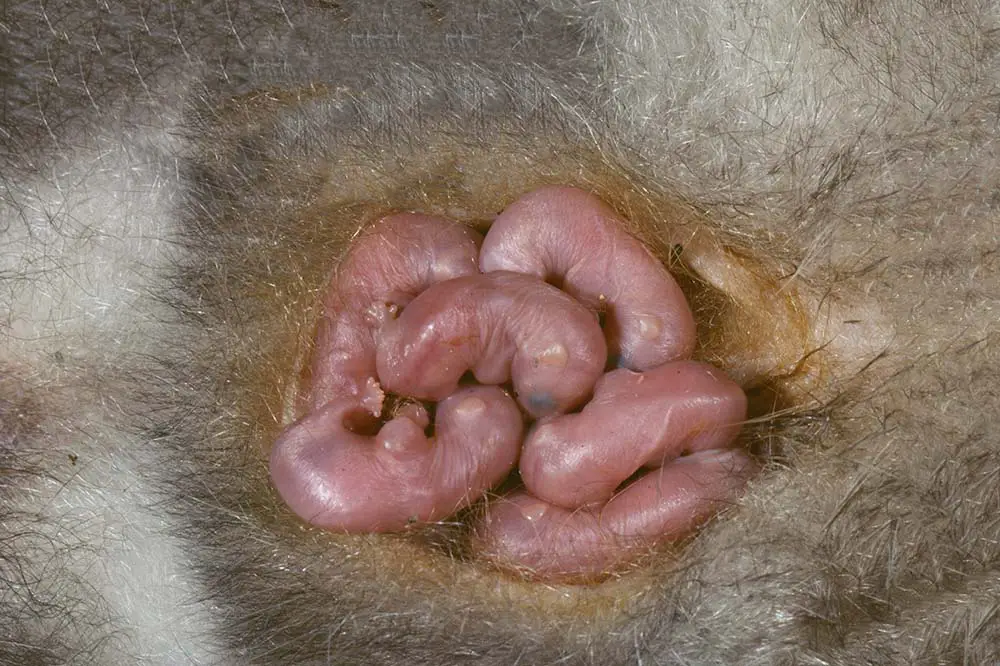
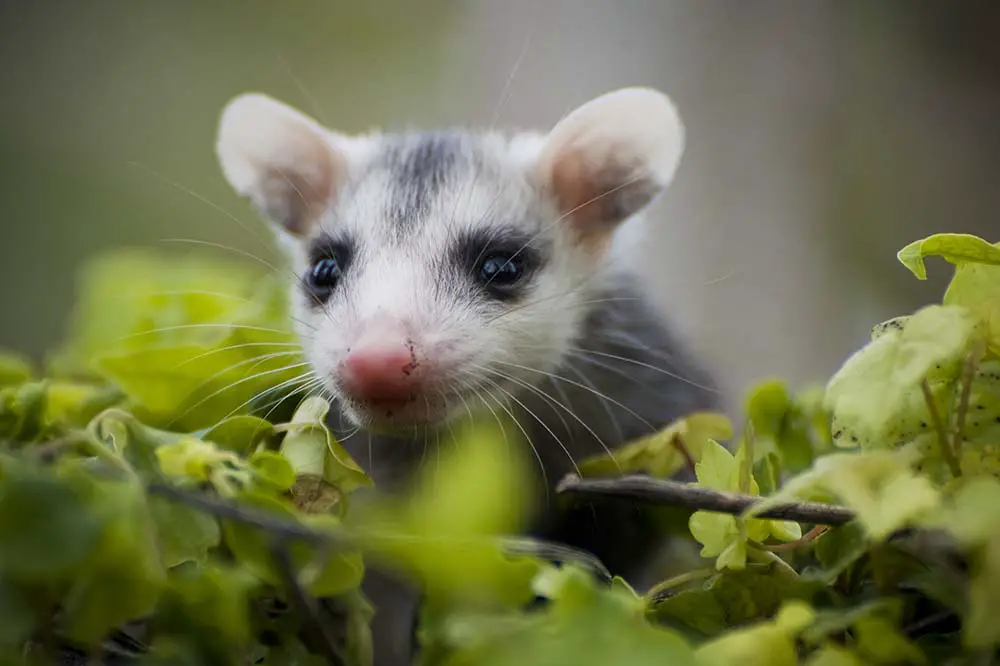
Left: Baby common opossums in mother’s pouch | Breck P. Kent / Shutterstock & Right: Baby Virginia opossum | Heiko Kiera / Shutterstock
The Virginia opossum is the only species found as far north as the United States and Canada and is also the largest, weighing up to 6 kg (13.2 lbs). They have short legs and compact bodies with a prehensile tail, which they use for grip while climbing. They are omnivores eating a combination of vertebrates, invertebrates and plant matter. The common opossum is contained in the same genus but is around a quarter of the size (1.5 kg 3.3 lbs). They are found throughout Central America and the northern half of South America. They can survive in a large range of habitats with the exception of day areas such as deserts, which is presumably why they don’t venture past central Mexico. Like the Virginia opossum, they are solitary and nocturnal.
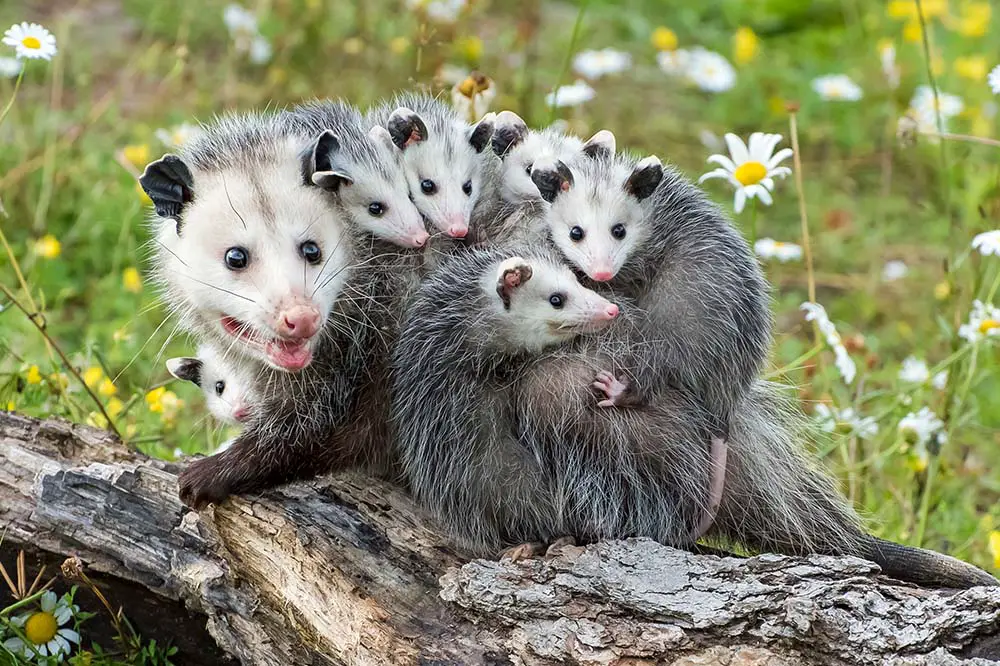
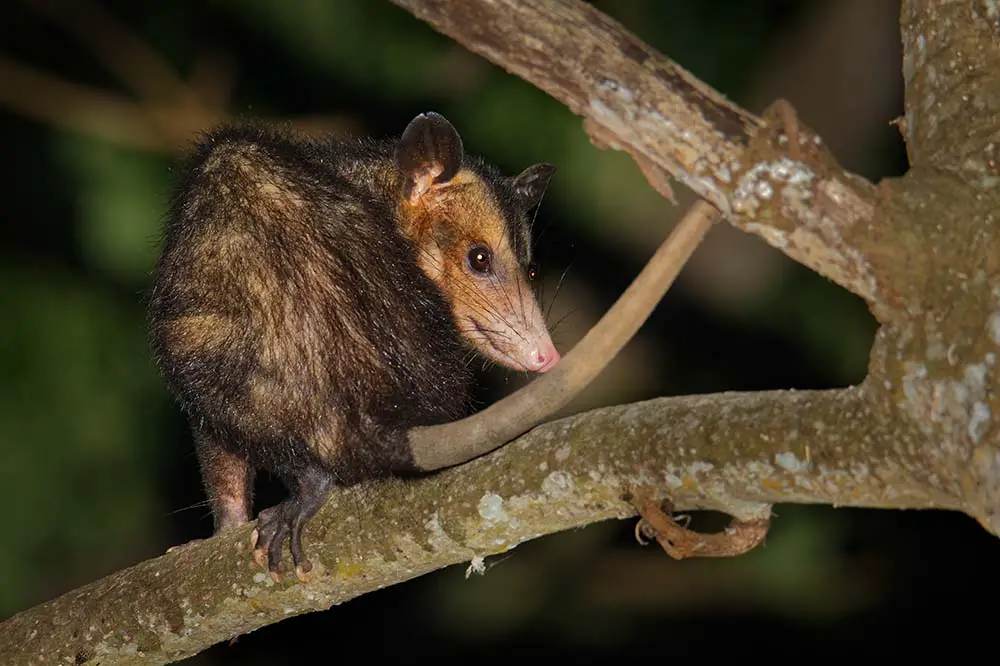
Left: Virginia Opossum | Evelyn D. Harrison / Shutterstock & Right: Common Opossum | Martin Pelanek / Shutterstock
There are two other species in the same genus that we’ll discuss, the white-eared opossum is found throughout most of the Southern half of South America, while the big-eared opossum is confined to the southeastern corner. The big-eared opossum is very similar in appearance to the common opossum and, in fact, was once considered a subspecies. They live in rainforests and highland areas up to an elevation of around 1,000m. The white-eared opossum is quite a bit larger, weighing around half of a Virginia opossum (2.7 kg / 17.5 lbs), and unsurprisingly has white ears. They have a surprisingly short lifespan with the average white-eared opossum living for just 20 months in the wild. Outside of this genus, the appearance and size of opossums change drastically.
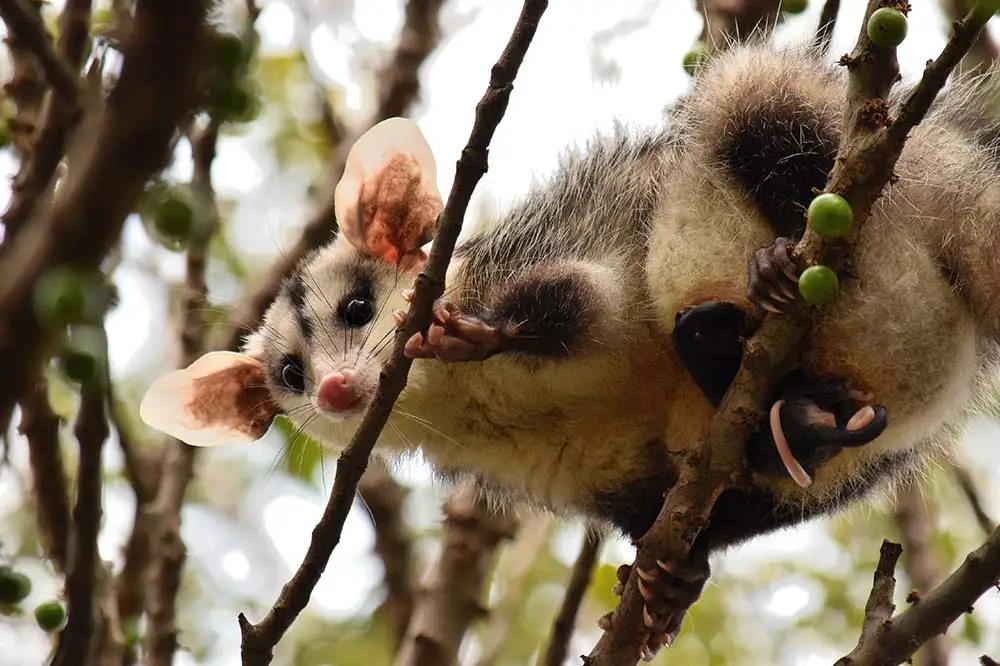
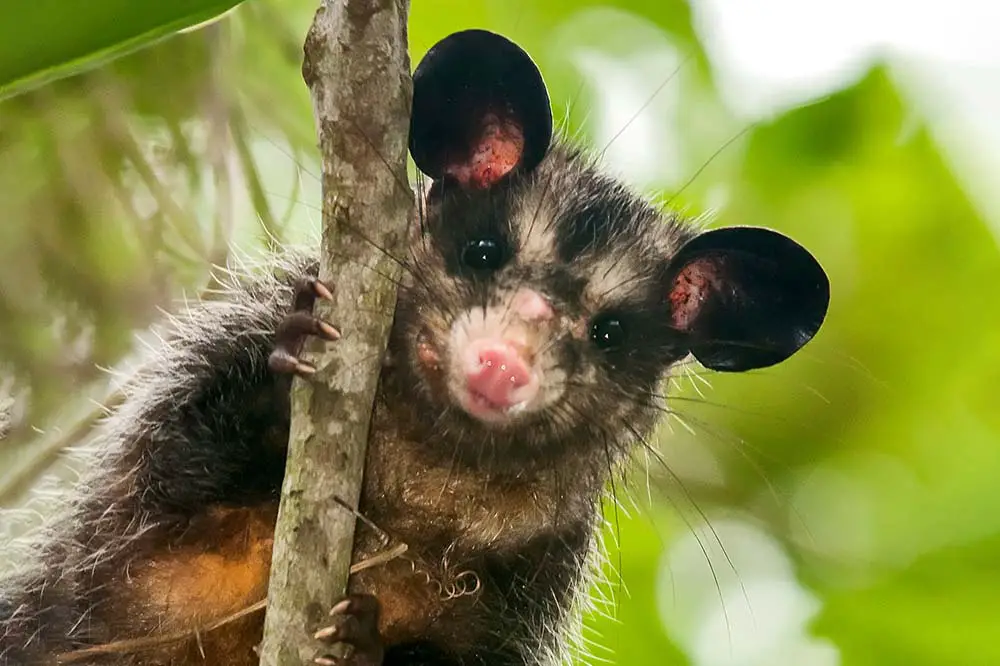
Left: A white ear opossum | Guilherme de Melo / Shutterstock & Right: Big-eared opossum | Leonardo Mercon / Shutterstock
The grey four-eyed opossum gets its name from the clearly defined white spots above its eyes. They are found in rainforest and scrub forest in Central and South America. Interestingly, although they live in the same area, they have almost the exact opposite range to the water opossum, which are also found on both continents. These water specialists are quite small, maxing out at around 800 g (790g / 28 oz) and are thought of as semi-aquatic, preying on amphibians, fish, crustaceans and insects.
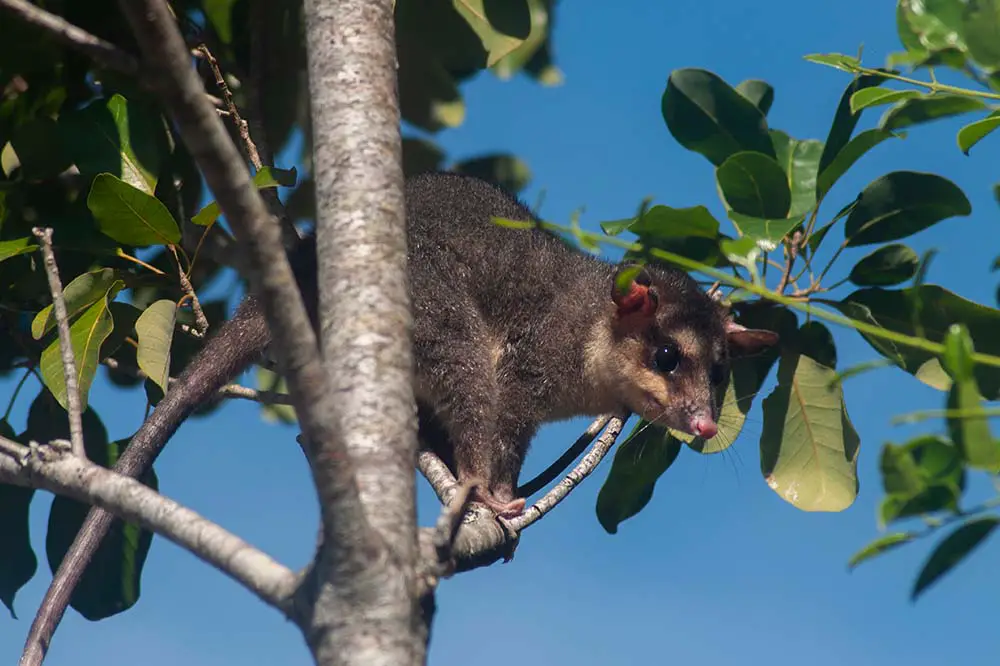
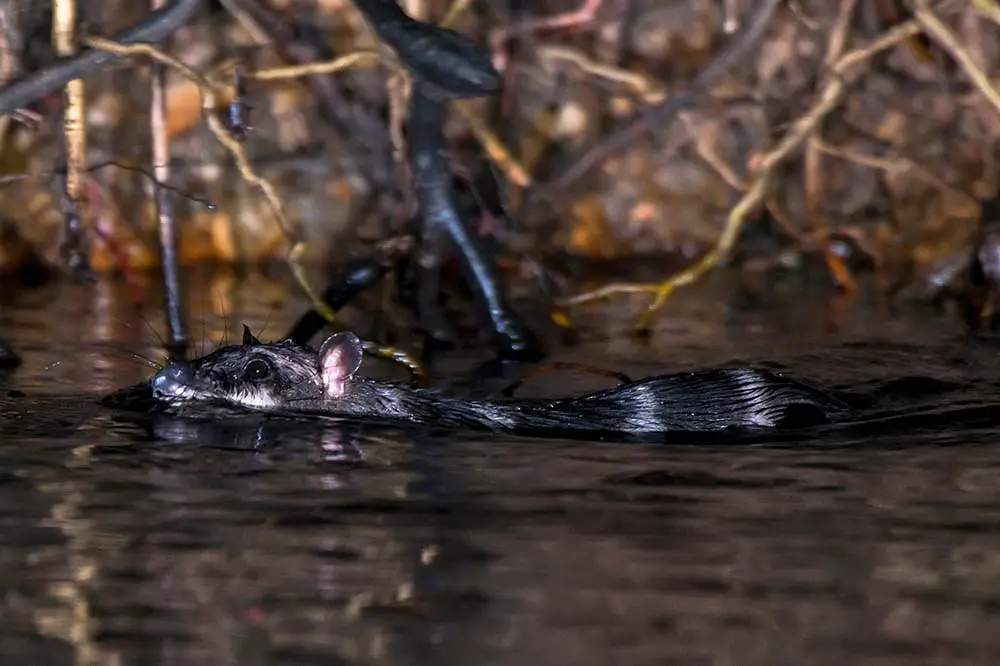
Left: Gray four-eyed opossum | Ilan Ejzykowicz / Shutterstock & Right: Water Opossum | Leonardo Mercon / Shutterstock
Venturing outside of the Didelphini tribe, these opossums are even smaller and more dissimilar in appearance. The five species mentioned in this section, the gray short-tailed opossum, the Northern three-striped opossum, Linnaeus’s mouse opossum, the Brazilian gracile opossum, and the Grey Slender opossum are all confined to South America. The gray short-tailed opossum is significantly smaller than the species previously discussed (155g / 5.5 oz) and looks more similar to the dunnarts found in Australasia. Their young can reach independence in as little as 6 to 8 weeks and females can have up to 5 litters per year. They are from the same genus as the northern three-striped opossum. Even smaller still, are the 25 species of mouse opossum found in the Marmosa genus. The species shown here, Linnaeus’s mouse opossum, weighs just 56 g (2 oz) and the Brazilian gracile mouse opossum is even smaller at just 45 g (1.6 oz). The final species of mouse opossum we’ll look at, the grey slender opossum has a particularly long tail, which is roughly 1.5 times the combined length of its head and body.
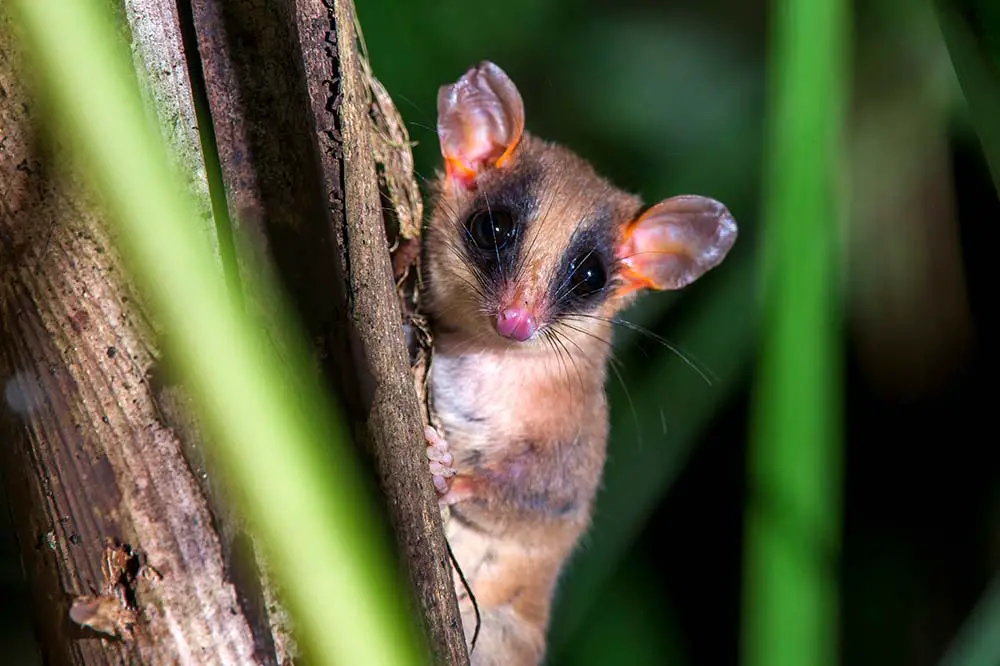
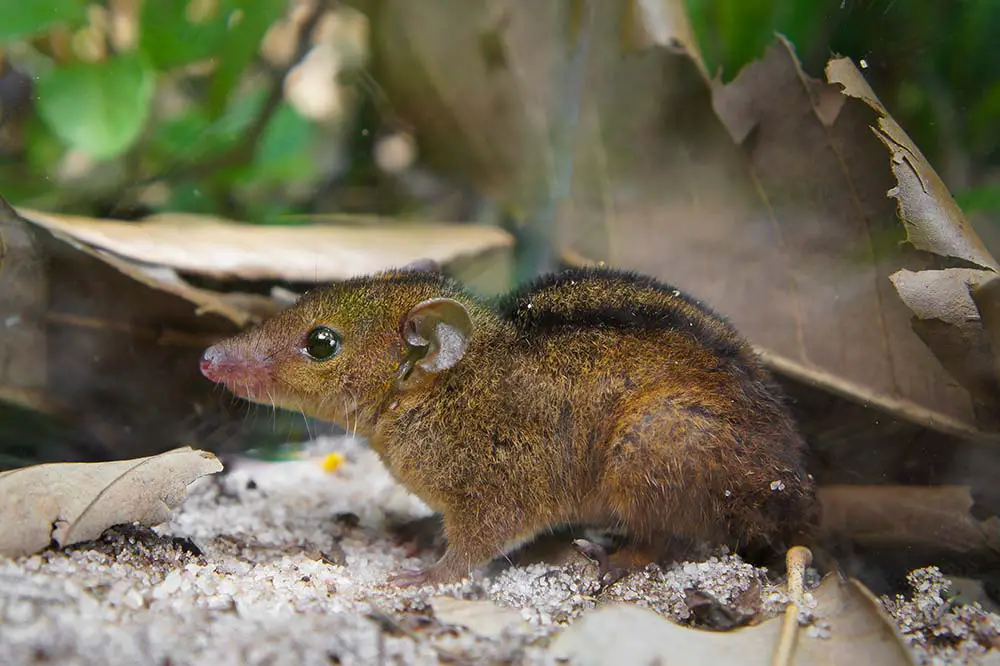
Left: Brazilian gracile opossum | Leonardo Mercon / Shutterstock & Right: Northern three-striped Opossum | Luis Renato R. Bernardo / Shutterstock
The Bare-tailed woolly opossum is the last species we’ll look at and are from a separate subfamily to the previous 11. They have a large range spanning from southern Brazil to northern Venezuela and in Kwazá, an indigenous language spoken in the Brazilian state of Rondônia, they are known as wakaro.
